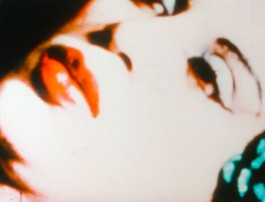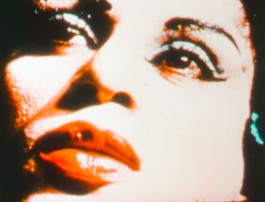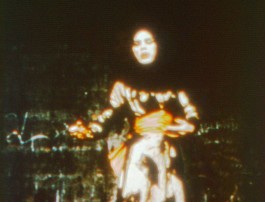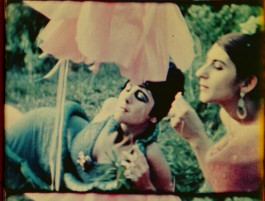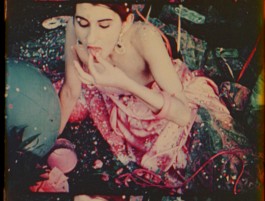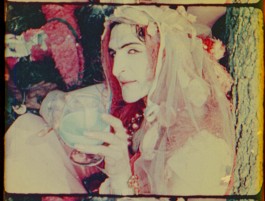16MM RUN is an experimental film programme in collaboration with MACRO conceived to present a selection of authors and titles out of the mainstream circuits, not easily available or that have rarely been screened in Italy. The programme includes mostly avant-garde and experimental films from the ‘60s, ‘70s and ‘80s without following a specific thematic focus. It is a hymn to the physicality of film in a time driven by digital. The programme took place between December 2021 — December 2024 at the Sala Cinema at MACRO. With the support of Fondazione Dino ed Ernesta Santarelli.
EDWARD OWENS, TAYLOR MEAD
10 December 2024
16MM RUN concludes on Tuesday, December 10, with Tomorrow’s Promise (1967, 44') by Edward Owens (1949–2010) and Home Movies Rome/Florence/Venice/Greece (1965, 14') and Home Movies N.Y.C. to San Diego (1968, 19') by Taylor Mead (1924–2013) — two filmmakers who challenged traditional formal and narrative conventions, crafting personal visual languages centered on the concept of travel.
The event, which marks the conclusion of the program that began in 2021, will feature Marco Giusti, film critic, essayist, television writer and director, for a conversation with Luca Lo Pinto and Vittoria Bonifati on the role of analog experimental cinema in the contemporary cultural landscape.
On this occasion, a limited edition collection will be presented, gathering the films that have been part of 16MM RUN: from the beginning of the series with Storm de Hirsch and Carolee Schneemann to today with Edward Owens and Taylor Mead, passing through Jack Smith, Maya Deren, and many others. Together, these films form a significant archive of experimental cinema from the ’60s, ’70s, and ’80s.
Edward Owens (1949–2009) è stato un regista afroamericano queer, protagonista del New American Cinema negli anni ’60. È noto soprattutto per i suoi film sperimentali Remembrance: A Portrait Study (1967) e Private Imaginings and Narrative Facts (1968-70). Ha studiato pittura e scultura alla School of the Art Institute di Chicago all'inizio degli anni '60 e più tardi film con il regista greco-americano Gregory J. Markopoulos, che ha insegnato lì tra il 1966 e il 1967. I film di Owens sono simili a quelli di Markopoulos del periodo, con l'uso del montaggio e delle sovrapposizioni per creare un senso di interrelazione e compenetrazione tra figure e oggetti. Markopoulos aveva incoraggiato il diciassettenne Owens a lasciare Chicago per New York, cosa che fece nel 1966, entrando nella cerchia di amici di Markopoulos e andando a vivere con il regista Charles Boultenhouse e il suo amante di lunga data, il critico Parker Tyler, che lo introdussero nel mondo dell'arte e della controcultura queer. Trasferitosi a New York City, Owens venne assunto da Jonas Mekas per lavorare alla Film-makers’ Cinematheque. Dopo aver visto i suoi film, Mekas lo invitò a unirsi alla Film-Makers’ Cooperative (FMC) per la distribuzione delle sue opere, riconoscendolo come parte integrante del movimento del New American Cinema. Owens ha vissuto a New York per diversi anni, fino a quando problemi di droga e depressione gli hanno fatto abbandonare la regia e tornare a Chicago. Nel 2016, la direttrice esecutiva di FMC, MM Serra ha collaborato con IndieCollect per preservare i quattro film di Owens presenti nella collezione NACG attraverso un processo di scansione digitale in 5K.
Taylor Mead (1924–2013) was born in Detroit, Michigan and raised by divorced parents mostly in the wealthy suburb of Grosse Pointe. He appeared in Ron Rice’s beat classic The Flower Thief (1960), in which he “traipses with an elfin glee through a lost San Francisco of smoke-stuffed North Beach cafes.. .” Film critic P. Adams Sitney called The Flower Thief “the purest expression of the Beat sensibility in cinema.” Village Voice film critic J. Hoberman called Mead “the first underground movie star.”In 1967 Taylor Mead played a part in the surrealistic play Desire Caught by the Tail by Pablo Picasso when it was set for the first time in France at a festival in Saint-Tropez, among others with Ultra Violet. In the mid-1970s, Gary Weis made some short films of Mead talking to his cat in the kitchen of his Ludlow Street apartment on Manhattan’s Lower East Side called Taylor Mead’s Cat. One film of Mead extemporizing on the virtues of constant television watching aired during the second season of Saturday Night Live. In 1995 Mead spent eight hours a day for a week at the Bon Temps bar, New Orleans, being documented in the photobooth costumed as a series of Warholian characters for Blake Nelson Boyd’s documentary Photobooth Trilogy. Characters included Superman and Mickey Mouse from Warhol’s Myth series and references to Mead’s performances in Lonesome Cowboys and Nude Restaurant. While living on Ludlow Street, Mead read his poetry regularly at The Bowery Poetry Club. His First book of poems Taylor Mead on Amphetamines and in Europe was written in 1968. His last book of poems is called A Simple Country Girl. He was the subject of a documentary entitled Excavating Taylor Mead, by Jim Jarmusch which debuted at the Tribeca Film Festival in 2005. The film shows him engaging in his nightly habit of feeding stray cats in an East Village cemetery after bar-hopping, and features a cameo by Jim Jarmusch, in which Jarmusch explains that once, when Mead went to Europe, he enlisted Jarmusch’s brother to feed the cemetery cats in Mead’s absence. Mead appeared in the final segment of Jarmusch’s 2003 film Coffee and Cigarettes. He has been “a beloved icon of the downtown New York art scene since the 60s.”
Edward Owens, Tomorrow’s Promise, 1967, 44'75''
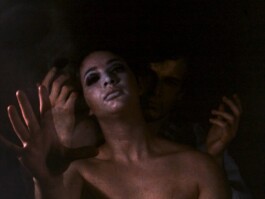
With Tomorrow’s Promise, Edward Owens explores existential void, identity, and introspection, combining intimate portraits, evocative imagery, and technically complex editing. The film carries a strong emotional charge, enhanced by the use of color and visual structure, which seem to suggest a shifting mood and an inner journey.
«Tomorrow’s Promise is a film about vacantness. Which physically does ‘begin’, reversed, upside down on the screen (but by what premise is it supported? , e.g. the film, so chimerical as life itself, follows its own way), suddenly another such position is taken (not in reverse), this time by a male figure and soon, in this same section, the girl of the reversed image reappears posed in a different way; a way obsessed by ‘mood’. Then a technical play of in-the-camera-editing occurs, more intense, brighter than in the first, reversed section. There are several inter-cuts which serve, in this and each subsequent section unto the end, as relative links into the final section: which is actually the ‘story’. The story the protagonist and her hero try to tell in their way is apophysis; except that ‘pictures’, clear visions take the place of words. My film could have been edited with precise tensions and a lucid straight narrative, but it was my aim to ‘re-create’ the protagonist of my personal life.» – Edward Owens
Taylor Mead, Home Movies
«My home movies which weigh 2 pounds so far began in Mexico City where I got bored and bought a 50-ft. Keystone at National Pawn Shop-I was immediately turned on-to the City, to Mexico-it really makes a difference-and in 16mm-but I wanted to shoot in color and it costs about 10 dollars/50 ft. in Mexico so I had to push single frame button much of the time-oh me, but its lovely anyway-I kept pushing once I crossed border into U.S. and N.Y. and Malibu. » Taylor Mead
Taylor Mead, Home Movies – Rome/Florence/Venice/Greece, 1965, 14'
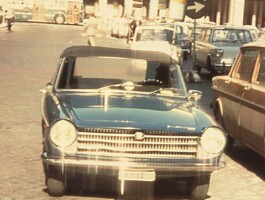
The film follows the author on a journey through some of the most iconic cities in Italy and Greece, including Rome, Florence, Venice, and various locations in Greece. Shot with a handheld video camera in an amateur and spontaneous style, the footage captures the essence of the 1960s “do-it-yourself” tourism, alternating between moments of Mead’s typical lightheartedness and irreverence and evocative images of the historic and cultural places visited. The combination of majestic settings and informal cinematography creates a personal and intimate account of a trip through Europe, with a laid-back and unconventional approach that reflects the free-spirited nature of the cinematic avant-garde of that time.
Taylor Mead, Home Movies / N.Y.C. to San Diego, 1968, 19'
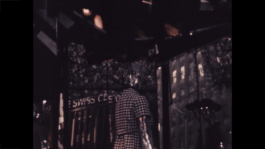
The film documents a journey starting from New York City and ending in San Diego, capturing fragments of daily life and random moments along the way. Shot in the amateur style typical of home videos, Mead uses a handheld camera to film spontaneous scenes, landscapes, and people encountered during the trip. The film reflects Mead’s experimental aesthetic and anarchic spirit, characterized by a free, unscripted approach. Without dialogue or a soundtrack, the short focuses on the images, presenting a visual journey through 1960s America with a sense of creative freedom and personal exploration.
KEIICHI TANAAMI
15 November 2024
Keiichi Tanaami (Tokyo, 1936-2024) actively crosses the boundaries between different artistic practices with his eclectic work as art director, graphic designer, illustrator, videographer and artist, and is today considered a role model for the current generation of interdisciplinary artists. Employing the design methodology of ‘editing,’ he has always engaged in a creative practice that extends beyond the framework of fine art, producing a diverse oeuvre ranging from collages to prints, drawings, animation, experimental films, paintings, three-dimensional works, and installations. He is widely recognized internationally as a Japanese pioneer in the ever-expanding context of pop art.
Tanaami’s recent solo exhibitions include Adventures in Memory (The National Art Center, Tokyo, 2024), PARAVENTI: KEIICHI TANAAMI (Prada Aoyama, Tokyo, Japan, 2023), Manhattan Universe (Venus Over Manhattan, New York, USA, 2022), A Mirror of the World (NANZUKA UNDERGROUND, Tokyo, Japan, 2022), Keiichi Tanaami (Kunstmuseum Luzern, Luzern, Switzerland, 2019), Keiichi Tanaami (Jeffrey Deitch, New York, 2019). He has also participated in major pop art retrospectives such as International Pop (Walker Art Center, Dallas Museum of Art, Philadelphia Museum of Art, USA, 2015-2016) and The World Goes Pop (Tate Modern, London, UK, 2015). Tanaami’s works are housed in numerous public collections including The Museum of Modern Art [MoMA] (USA), Walker Art Center (USA), The Art Institute of Chicago (USA), M+ (Hong Kong), National Portrait Gallery (USA), Hamburger Bahnhof (Germany).
Marionettes in Masks, 1965, 8'
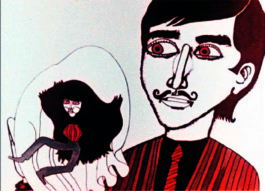
Courtesy the artist and Nanzuka
This animated film, along with A Portrait of Keiichi Tanaami released the following year, focuses on the themes of face and identity. Tanaami viewed the myriad faces seen daily in the media as interchangeable “masks,” and presented them as symbolic representations of contemporary life. The marionettes in various masks embody a spectrum of personas, in styles ranging from painterly strokes to American comic-style illustrations. However, the marionettes ultimately collapse, overwhelmed by the dizzying speed of the information deluge. The direct influence of Pop Art on these motifs points to the artist’s desire to integrate new art movements into animation.
Commercial War, 1971, 4'30''
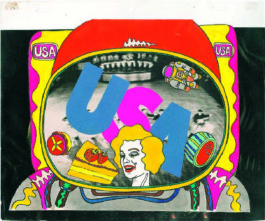
Courtesy the artist and Nanzuka
Following a countdown, six sequences unfold in succession. Visual elements from ads for Coca-Cola, hamburgers, and cosmetics are combined with audio clips from Japanese TV commercials. These juxtapositions generate a pronounced sensation of cognitive dissonance, and removed from their original advertising contexts, the images and words take on a satirical tone. The first sequence in particular includes sporadic audio fragments that evoke a parliamentary debate, conveying an ironic take on the relentless flood of images and information disseminated by television and the emptiness of political rhetoric. In the final scene, a photograph of a crowd with indistinct faces is paired with dialogue that might be interpreted as critiquing the public itself.
Good-by Elvis and USA, 1971, 7'3''
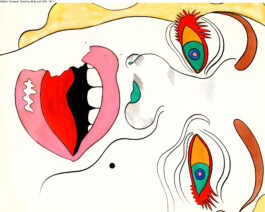
Courtesy the artist and Nanzuka
As in Good-by Marilyn, Tanaami’s method of appropriating American pop culture while infusing it with his own sensibility is apparent in this animated film. It presents a series of moving images superimposed in collage-style, including photographs of movie stars like Elvis Presley and Marlon Brando as well as Tanaami’s frequently recurring motifs of erotic illustrations and fighter planes. Tanaami first visited the United States in 1970, and recalled that he avidly acquired inexpensive popular magazines there. Photographs and a magazine cover, dated January 1971, included in this work hint at his personal experiences in the U.S.
Good by Marilyn, 1971, 4'25''
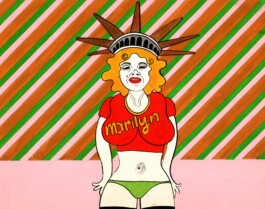
Courtesy the artist and Nanzuka
This is one of the animated films Tanaami produced for the television program 11PM. It deploys reiterated eroticized motifs such as hot dogs, bananas, and pornographic cutouts intermingled with depictions of Marilyn Monroe wearing the Statue of Liberty’s crown as well as various Disney-style characters, creating a lively and rhythmic visual flow. Symbols of American pop culture are interwoven with Japanese cultural elements, such as the famous Glico sign in Osaka’s Dotonbori district and background music featuring the singing of Miki Hirayama. The inclusion of fighter planes and the Vietnamese flag, evoking war, further integrates disparate elements into Tanaami’s signature visual vocabulary.
Study of the Virgin in School Uniform Stripped Bare by Her Bachelors, 1972, 3'45''
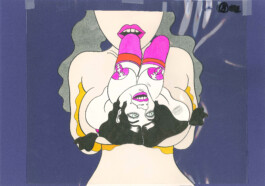
Courtesy the artist and Nanzuka
This work is clearly influenced by Marcel Duchamp’s “The Bride Stripped Bare by Her Bachelors, Even” (commonly known as “The Large Glass”), with a title that references Duchamp’s ironic approach to art. Keiichi Tanaami uses Duchamp’s work as a foundation to satirize Japan’s art scene at the time, filtering it through his own unique perspective. When this piece was released in the early 1970s, Japan’s artists were witnessing the waning of avant-garde energy, as they were increasingly being drawn into national projects in the midst of rapid economic growth. Within this context, Tanaami’s work, influenced by the psychedelic culture of the 1960s and Neo-Dada, boldly explores experimental expression through the medium of film.
Oh Yoko, 1973, 5'
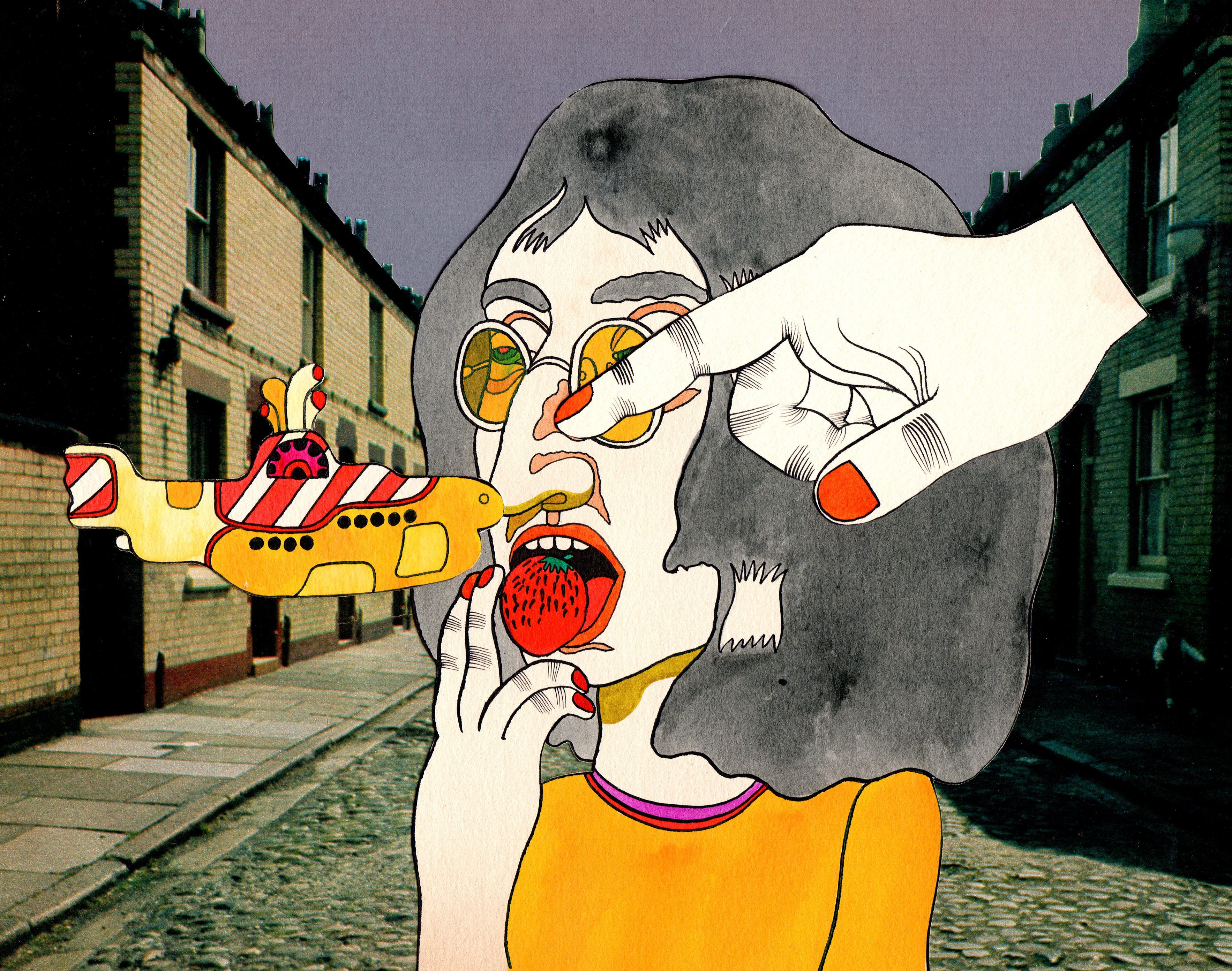
Courtesy the artist and Nanzuka
Set to John Lennon’s 1971 song “Oh Yoko!,” this animated film interweaves illustrations and photographs of Lennon and Yoko Ono with trademark Tanaami motifs such as insects and airplanes. It also features many elements associated with the Beatles, including submarines, strawberry fields, and the elephant-headed Hindu deity Ganesh. Vivid colors and shapes reminiscent of the animation in the 1968 Beatles film Yellow Submarine permeate the work, illustrating Tanaami’s active integration of influences from the counterculture of the day.
Crayon Angel, 1975, 3'
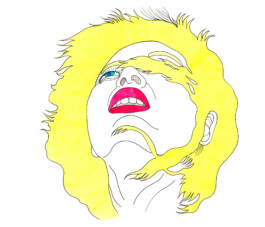
Courtesy the artist and Nanzuka
This film represents a shift away from the vibrant Pop motifs that characterized Tanaami’s 1960s work and toward more intense wartime imagery. Motifs such as a woman blasted by a shockwave and chickens squawking in terror at the sound of air-raid sirens are drawn from his actual memories. Images of prewar comedians like Ken’ichi Enomoto laughing and photographs from Tanaami’s youth are seen through a grid-like filter, conveying the distance between the adult Tanaami and his childhood memories. The continuous heartbeat sound heard throughout the piece emphasizes the introspective nature of the work, which enables viewers to vicariously share Tanaami’s exploration of deep memory layers.
Sweet Friday, 1975, 3'17''
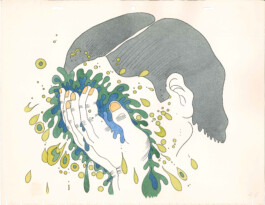
Courtesy the artist and Nanzuka
This animated film depicts morning on Tanaami’s favorite day of the week, Friday, set to light-hearted music. It follows his waking routine of washing his face, wiping his glasses, eating breakfast, and taking a shower. Various scenes from his imagination are interspersed among these daily actions with a flicker effect that evokes experimental films. Images include a sparrow he projected with a magic lantern as a child, goldfish his grandfather kept during World War II, and white female nudes, all juxtaposed without apparent connection, reflecting a morning mental state of interplay between the fantastical and the mundane. The inclusion of a letter and photographs from his close friend Ushio Shinohara offers a glimpse into Tanaami’s actual personal life. out the piece emphasizes the introspective nature of the work, which enables viewers to vicariously share Tanaami’s exploration of deep memory layers.
Why, 1975, 10'
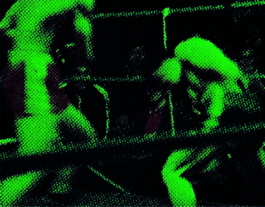
Courtesy the artist and Nanzuka
Around this time Tanaami began integrating printing techniques into his film production, inspired by the reading of a newspaper article the morning after a Muhammad Ali fight. He was struck by the coarse, gritty texture of the printed photo, which to him conveyed greater immediacy and impact than television footage, and began exploring this tactile quality in his works. This particular work was driven by interest in the visual effects of enlarging and animating the halftone dots of newspaper and magazine photographs. In the film, enlarged dots gradually decrease in size, ultimately revealing a scene of a boxing match. The boxers’ clumsy movements, accompanied by sporadically off-key piano, showcase Tanaami’s whimsical sense of humor.
Trip, 2005, 5'
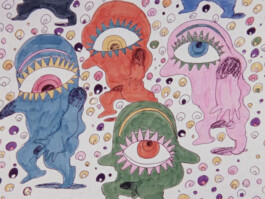
Courtesy the artist and Nanzuka
A visionary animation collaboratively crafted by Keiichi Tanaami and Nobuhiro Aihara, two iconic figures in the realm of Japanese experimental cinema. This film delves into the psychedelic and surrealistic visual language both artists are renowned for, offering a vivid journey through the subconscious. Melding fluid, hand-drawn animation with vibrant and disorienting imagery, Trip encapsulates the chaotic interplay of dreams and memories.
Chirico, 2008, 4'30''
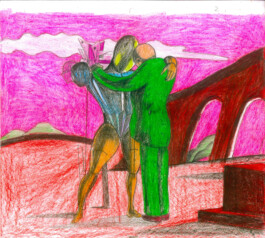
Courtesy the artist and Nanzuka
This film is inspired by the paintings of Giorgio de Chirico: his paintings seemed to Tanaami like frozen instants within sequences of images, and he felt the urge to make them move through animation. The film starts with a scene from de Chirico’s Mystery and Melancholy of a Street (1914) in which a girl pushes a hoop. We then see de Chirico’s self-portrait merge with a faceless mannequin, and a surrealistic world based on the metaphysical painter’s style. Through the creative synergy of Tanaami and Nobuhiro Aihara, static images from de Chirico’s paintings are woven into a vibrant animated narrative.
BARBARA HAMMER, BETTE GORDON
23 October 2024
Feminist filmmaker and pioneer of queer cinema, Barbara Hammer (1939-2019) made over 90 moving image works as well as performances, installations, photographs, collages and drawings. In the early 1970s Hammer studied film at San Francisco State University. After seeing Maya Deren’s film Meshes of the Afternoon, she was inspired to make experimental films about her personal life. After coming out as a lesbian she “took off on a motorcycle with a super-8 camera” and in 1974 filmed Dyketactics, widely considered to be one of the first lesbian films. Hammer sought to deconstruct and disempower the narratives and structures that oppress women in general and lesbians in particular. From her earliest experimental work, her films are playfully and relentlessly challenging accepted norms and taboos. In the last decade of her life, Hammer was given retrospective exhibitions in several internationally major museums and in 2017 her paper archive was acquired by the Beinecke Rare Book and Manuscript Library at Yale University. Hammer also established the Barbara Hammer Lesbian Experimental Filmmaking Grant—awarding the first grant in 2017.
Bette Gordon (1950, USA), a pioneer in the American Independent Film world, is best known for her bold explorations of themes related to sexuality. Her early short films, most notably Empty Suitcases, won numerous awards and Festival acclaim worldwide, including showings at the Berlin International Film Festival, New York’s Museum of Modern Art and The Whitney Biennial. Variety (1984) marked her debut as a feature film director, particularly in light of the film’s invitational showing at The Cannes Film Festival’s Director’s Fortnight. Bette Gordon has collaborated extensively with James Benning in the '70s on films such as The United States of America (1975), Michigan Avenue (1973) and i-94 (1974). Gordon holds a BA, MA, and MFA from The University of Wisconsin – Madison and is now a part of the film department of Columbia University School of the Arts. Some of her films are now part of permanent collections in several different museums including the Museum of Modern Art and the Whitney Museum of American Art.
Women I Love, 1976, 22'39''
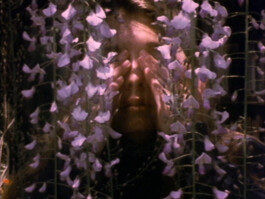
Courtesy the artist and Light Cone
Women I Love is a series of cameo portraits of the filmmaker’s friends and lovers intercut with a playful celebration of fruits and vegetables in nature. Culminating footage evokes a tantric painting of sexuality sustained. Each lover is compared with a colorful flower, or a fruit or vegetable peeling open from its core in animated pixelation. Using double-exposure, out-of-date stock, the relationships are portrayed with a strong sense of the romantic. The lovers’ identities are never presented; rather the women are objectified and idealized. The film form tells us much about “lesbian lifestyle”; the relationships are clearly delineated yet it seems the traces of one relationship’s failure are repeated in the next.
No No Nooky T.V., 1987, 12'
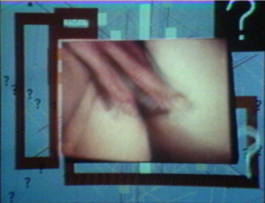
Using a 16mm Bolex and Amiga computer, Hammer creates a witty and stunning film about how women view their sexuality versus the way male images of women and sex are perceived. The impact of technology on sexuality and emotion and the sensual self is explored through computer language juxtaposed with everyday colloquial language of sex. No No Nooky T.V. confronts the feminist controversy around sexuality with electronic language, pixels and interface. Even the monitor is eroticized in this film/video hybrid that pokes fun at romance, sexuality, and love in our post-industrial age.
Empty Suitcases, 1980, 48'75''
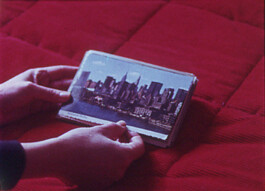
«Empty Suitcases is a narrative derived from film’s own material and my concern for exploring issues of representation and identification in cinema. The film presents fragments of a woman’s life–her work as a photographer, her friendship and relationships; in short, her economic, sexual,and artistic struggles. By deconstructing the fragments of text, speech, music and picture, the film forces focus on the workings of narrative, as well as on the narrative itself. Central to Empty Suitcases is women’s inability to place and define themselves in language and politics, the location of radical struggle. This displacement leads to a definition of woman as other, and reveals problems of unresolved sexual relations, difference, and violence» (Bette Gordon). According to J. Hoberman (Village Voice), her most successful sequences – a militant ‘new wave’ fashion show in which models photograph themselves, an expressionless white woman lip syncing along to Billie Holliday, a scene where the filmmaker relates a dream only to be drowned out by Talking Heads singing Psycho Killer – all criticize conventional modes of representation, with particular attention to what current academic jargon calls ‘the imaging of woman’.
BRUCE CONNER
15 May 2024
Bruce Conner (1933 – 2008) is today recognized as one of the most important American artists of the 20th century, renowned for his work in film, assemblage, drawing, sculpture, painting, collage, photography, and conceptual pranks. Born in McPherson, Kansas and raised in Wichita, in 1957 he dropped out of the MFA program at the University of Colorado in Boulder and moved to San Francisco. Emerging from the California art scene, in which he worked for half a century, Conner’s work touches on various themes of postwar American society, from a rising consumer culture to the dread of nuclear apocalypse.
Conner earned a national reputation with his shocking sculpture Child (1959), a grotesque wax figure lashed to a high chair with nylon stockings and for his pioneering assemblages, which he called Rat Bastards. Between 1957 and 1964 he made nearly two hundred of these hybrid accretions of found objects bound together with nylons. For materials Conner raided junk shops and run-down Victorian houses using scavenged objects and adopting a self-consciously marginalized stance, creating sculptures inspired by installations made by local junk dealers and other store owners.
Equally a pioneer of avant-garde filmmaking, Conner turned to film with A Movie in 1958 with a freewheeling curiosity and resistance to pigeonholing that would last throughout his lifetime. He developed a quick-cut method of editing that defined his oeuvre. Incorporating footage from a variety of sources—countdown leaders, training films, and newsreels—and adding later his own 16mm film footage, Conner’s films also focus on disturbing but utterly current themes. A key figure in the Beat counterculture of the 1950s, Bruce Conner rejected bourgeois ideals of art as an expression of privileged creativity that produces a beautiful, eternal object. Instead, he challenged artists to deliver new forms based on new values—spontaneity, impurity, the degraded, and the marginal. In 1968, anxious to evade easy classification, Conner gave up his New York representation and turned increasingly to performance and conceptual art. Working fluidly in a range of media and later associating with the hippie and punk subcultures, he remained a restless maverick.
LOOKING FOR MUSHROOMS (Long version), 1959-67/1996, 16mm, color, sound, 14'
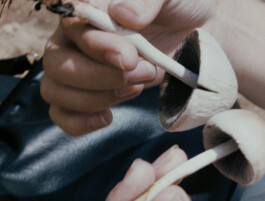
Courtesy of the Conner Family Trust / © Conner Family Trust
Looking for Mushrooms (1959-1967) is a psychedelic travelogue film that documents a series of “trips” through rural Mexico and urban America. Conner combined street views of San Francisco shot in the late 1950s with scenes of rural Oaxaca captured during his “mushroom-hunting” excursions between 1961 and 1962, when Bruce and his wife, the artist Jean Sandstedt, were living in Mexico City. On at least one of these trips, the Conners were joined by Timothy Leary, the ex-Harvard professor and soon-to-be leading proponent of psychedelic drugs. Whereas an earlier version of the film was silent and played on a loop, in 1967 Conner added a rock ’n’ roll soundtrack, The Beatles’ Tomorrow Never Knows off their 1966 album Revolver. Conner often noted that this version of Looking for Mushrooms (along with Cosmic Ray) was often rented by advertising agencies, which were presumably interested in his use of quick-cut editing and strobe effects to generate visual disorientation and subliminal messages. In 1996, Conner revised the film once again: he used an optical printer to expand its length from three to fourteen-and-a-half-minutes, and added a new soundtrack, Terry Riley's Poppy Nogood and the Phantom Band, to create a more meditative, but no less hypnotizing, iteration of the mushroom hunt.
COSMIC RAY, 1961,16mm, black/white, sound, 4'
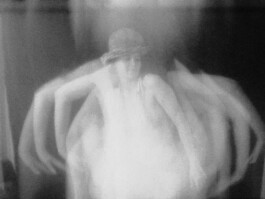
Courtesy of the Conner Family Trust / © Conner Family Trust
Many attribute the birth of the music video to Conner's 1961 film "Cosmic Ray: a reckless collage of fast moving parts: comic strips, dancing girls, flashing lights. It is the dancing girl - hardly dressed, stripping or nude - which provides the leitmotif for the film. Again and again she appears - sandwiched between soldiers, guns, and even death in the form of a skull positioned between her legs. And if the statement equates sex with destruction, the cataclysm is a brilliant one, like an exploding firecracker, and one which ends the world with a cosmic bang. Of course, the title also refers to musician Ray Charles whose art Conner visually transcribes onto film as a potent reality, tough and penetrating in its ability to affect some pretty basic animal instincts. But if such is the content of the film - that much of our behaviour consists of bestiality - the work as a whole stands as insight rather than indictment." — Carl Belz, Film Culture. The soundtrack of the film is What'd I Say (Live from Atlanta, 1959) by Ray Charles.
BREAKAWAY, 1966,16mm, black and white, sound, 5'
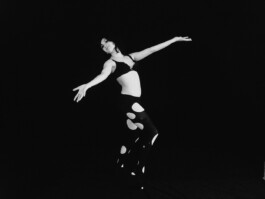
Courtesy of the Conner Family Trust / © Conner Family Trust
Breakaway is a dynamic five-minute homage to the female form, counterculture, pop music, and the kinetic possibility of cinema. It is also one of the few films shot by Conner himself, rather than material found from other sources. The location was a collector’s house in Santa Monica. Conner’s friends, the actors Dean Stockwell and Dennis Hopper, held the lights, and the subject was Antonia Christina Basilotta, a young singer and choreographer, dancing and writhing frenetically to her song Breakaway, with music by Ed Cobb. The five-minute film opens with a flickering image of Basilotta posing against a black background, dressed only in a black bra and black tights into which holes have been cut. After a few seconds the music starts: the B-side of the titular single released in February 1966 under her stage name Toni Basil, a driving, high-tempo track which sets the pace for the film. Basil’s dancing is lively, but through Conner’s quick-zoom camera and stroboscopic editing it becomes almost frenetic, her underwear changing—then disappearing—in the blink of a camera’s gate. Just over two minutes into the film, as the song fades and the screen goes black, the film plays in reverse, sound and vision, from its end to its beginning. The film was shot at single frame exposures as well as 8, 16, 24 and 36 frames per second.
THE WHITE ROSE, 1967, 16mm, black/white, sound, 7'
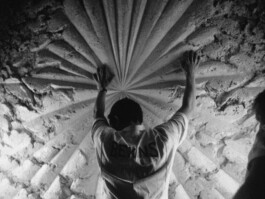
Courtesy of the Conner Family Trust / © Conner Family Trust
In 1965, Bruce Conner filmed fellow artist Jay DeFeo and her monumental, then-unfinished artwork, The Rose (1958–66), in the moments leading up to its extraction from her San Francisco studio. In an obsessive, implacable quest, DeFeo devoted over eight years of her life to The Rose, a radiant accumulation of mica and oil paint that blurred distinctions between painting and sculpture. Prior to The Rose’s completion, DeFeo was evicted from her studio and forced to uproot her possessions and her art. Conner’s resulting film, The White Rose (1967), situates DeFeo’s masterpiece as its protagonist, documenting its forceful prying from the bay window in which it was made, as well as its journey to the sidewalk below and the moving truck that carries it away. The soundtrack of the film is Sketches of Spain by Miles Davis.
VALSE TRISTE, 1978, 16mm, sepia/sound, 5'
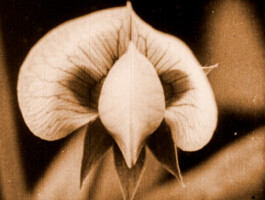
Courtesy of the Conner Family Trust / © Conner Family Trust
Valse Triste is a homage to surrealist cinema and a belated trance-film (the psychodramas of Maya Deren, Kenneth Anger and Sidney Peterson date from the 1940s, the time of Conner's adolescence). Autobiographical of Conner’s Kansas boyhood, the film also reworks the debased popular 'dream sequence', principally by imitating one of its cliche-prone situations—a boy's dream about steam engines, daily chores, home travel and girls. Shorn of context, ordinary images keep their typicality but gain uniqueness, mystery and the aura of memory. Beneath the period charm are disturbing ripples. Conner's imitation of the dream form is not a parody or a mockery, but it frames ironies as complex as in his other films, as deeply rooted in American social life. Each item of the collage retains something of its former identity — the footage of battered trucks, floods and the pervading melancholic mood, all evoke a very undreamlike social fact, the stubborn survival of life after a recent past of poverty and depression.
AMERICA IS WAITING, 1981, 16mm, b&w/sound, 3'5''
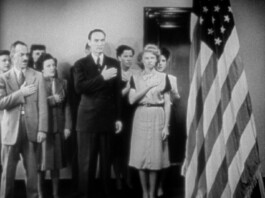
Courtesy of the Conner Family Trust / © Conner Family Trust
America is Waiting (1981), like Conner’s earlier films, is a compilation, a wacky assortment of bits and pieces of old newsreels, educational films, Hollywood movies, ’50s TV commercials, and hermetic fragments of industrial “film features”. Conner’s films are resurrections of sorts and, like most resurrections, there is something about them that is both ghoulish and uncanny. America is Waiting is about America, about American culture in general, and about American self-image as articulated by attitudes toward national strength, patriotism, and a vanished Golden Age of cherished national ideals. It is a film that articulates images of war, death, and disintegration in a way that pointedly challenges and subverts this legacy. The title of the film is taken from its sound track, the David Byrne/Brian Eno song from My Life in the Bush of Ghosts. The sound track cues the editing in Conner’s film, providing a running commentary on the image as a way of generating a complex of meaning and association.
A MOVIE, 1958, 16mm, black/white, sound, 12'
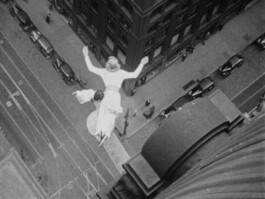
Courtesy of the Conner Family Trust / © Conner Family Trust
With A Movie (1958), Conner launched a lifelong celebration of moving images alongside his other artistic practices of collage, assemblage, drawing and photography. He reconceived mid-century notions of cinema itself, as A Movie simultaneously explores the very nature of cinema and montage in the modern era. Comprised of discarded 16mm films purchased at flea markets or scavenged from camera shops, A Movie has been described by many as the first contemporary “found footage film.” Conner crafted this work with care and absolute precision, qualities that would define his entire oeuvre in diverse media. A Movie orchestrates a virtual symphony of disasters, car crashes, explosions, war, famine, as well as serene moments of grace—a tightrope act, a plane floating through clouds, light reflected on water. Although seemingly random in its sequence of imagery, A Movie abstractly yet deftly moves the viewer through a wide range of human experience and emotion. With Respighi’s Pines of Rome as the soundtrack to A Movie, Conner established a visual poetry that combines music and image.
CHARLES HENRI FORD
23 April 2024
Johnny Minotaur (1971, 80’) is a film by surrealist artist and poet Charles Henri Ford. It is a lyrical explosion of taboos: incest, intergenerational desire, pansexuality and autoeroticism are a few of the issues he grapples with through mythopoeic and sensual imagery. Shot during a sojourn on Crete, the film revives the Minotaur myth in modern times and includes appearances and footage by Allen Ginsberg, Warren Sonbert, Lynne Tillman, Salvador Daliand other artists and writers who had migrated to Greece during the 1960s. Unseen for over two decades, The New American Cinema Group, Inc./The Film-Makers Cooperative has restored Johnny Minotaur and resurrected this classic of forgotten, queer cinema that belongs alongside the films of Kenneth Anger, Derek Jarman and Jean Genet.
Charles Henri Ford (1908–2002) was a surrealist poet, magazine editor, filmmaker, photographer and collage artist. He published more than a dozen collections of poetry, exhibited his artwork in Europe and the United States, co-founded and edited the Surrealist magazine View (1940-1947) and directed an experimental film. He was the co-author of the first proto-queer American novel The Young and Evil (1933); he was also part of the inner circle of Gertrude Stein in Paris in the 1930s and, in the 1960s, Ford was an important influence on Andy Warhol and New York’s literary and art communities. His oeuvre is grounded by a consistent interest in the pairing of word and image and by a tendency toward playful, twisted appropriations of the various cultural movements of which he was part.
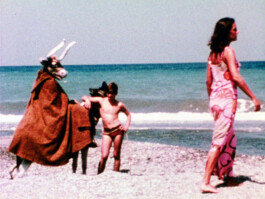
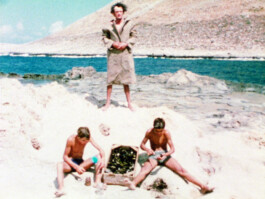
MARIO SCHIFANO, HARRY SMITH
13 October 2023
The ninth appointment of 16MM RUN presents at the MACRO screening room a series of short films by Mario Schifano (1934-1998) and Harry Smith (1923-1991), in a face-off between two outstanding protagonists of the experimental art and film scenes of Rome and New York: Mirror Animations (1979), Late Superimpositions (1964) by Smith, and Reflex (1964), Ferreri (second half of the 1970s) and Souvenir (1967) by Schifano.
Mario Schifano was an artist, painter and filmmaker, best known as one of the fundamental figures of Pop Art in Italy. The boundaries between cinema and art were redefined by Schifano, where his use of the camera is at the same time operative tool and plastic subject. In his films there is no conception of time or narrative development, they are usually filmed diaries capturing the people, places, objects and paintings that gravitated around him, at the height of his artistic and existential creativity. “Cameras are things that have always served me to reproduce spaces and figures that I could stay with even when I was alone. […] It’s just that men are more like cinema than painting: in a film they walk, they eat, they make love, as it really happens; in painting they don’t” (Schifano).
Harry Smith was a visual artist, experimental filmmaker, record collector, bohemian, mystic, largely self-taught student of anthropology, and Neo-Gnostic bishop. Smith was an important figure in the Beat Generation scene in New York City. Besides his films, most notably his full length cutout animated film Heaven and Earth Magic (1962), Smith is also widely known for his influential Anthology of American Folk Music, drawn from his extensive collection of out-of-print commercial 78 rpm recordings, one of the most influential releases in the history of recorded sound.
Mario Schifano, Reflex, 1964, 16'
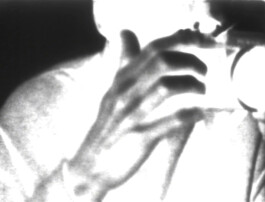
Reflex is the first experimental short film shot in America by Schifano. It is focused on the figure of the fashion photographer Bob Richardson, while portraying some models in his studio during a photoshoot (a theme similar to the one of Blow up the famous film shot by Michelangelo Antonioni two years later, in 1966). Schifano himself is also present in this film, you can see his image reflected in a mirror, holding his camera, as signified that the real focus here is on the media itself, not on the models or on the photographer. At a certain point we see one of the models taking a swig from a bottle of Coca-cola, a recurring theme in Schfiano’s oeuvre.
Mario Schifano, Ferreri, 16'
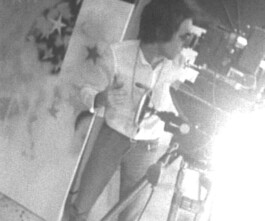
Mario Schifano was a close friend of Italian film director, screenwriter and actor Marco Ferreri, filmed here in their meetings. The film shows private images of the two artists, also featuring Mimmo Rotella and Franco Brocani.
Mario Schifano, Souvenir, 1967, 11'
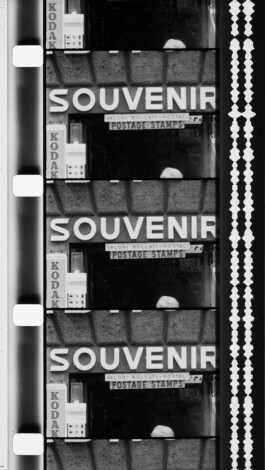
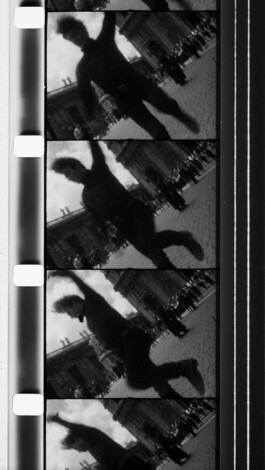
In Souvenir, Mario Schifano films Peter Hartman and Gerard Malanga during their visit at the St. Peter’s Basilica in Rome. Schifano and his friends wade their way through the masses of visitors to the basilica. Their bodies and their unusual “performances” and dances form a sort of contrast to the new religion of mass tourism, which Schifano immortalizes in its most common, stereotypical – in a way pop – details. Although most of these first Schifano experimentations have no sound, in this case we can hear in the background a music and a voice (probably Malanga), reciting poems, in a sort of litany that accords well with the atmosphere of this new kind of “religion” that permeates the film. At the end of the film, the protagonist injects himself with an illicit substance on top of Gian Lorenzo Bernini’s famous colonnade. The director seems interested in drawing a parallel between the desecrating behavior of the protagonist in the holy place and the blasphemous speculation around the sale of sacred images.
Harry Smith, Mirror Animations, 1979, 11'
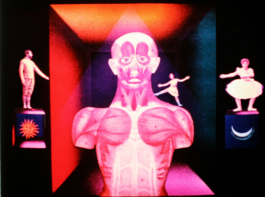
“If, (as many suppose), the unseen world is the real world and the world of our senses but the transient symbols of the eternal unseen, ad limiting ourselves to the aesthetic experience’s well-known predilection for the eyes and ears, we could logically propose that any one projection of a film is variant from any other. This is particularly true of Mirror Animations. Although studies for this film were made in the early 1960s, the non-existence of suitable printing equipment until recently, my inability to locate the original camera footage until 1979, and particularity, the lack of an audience ready to evaluate L. Wittgenstein’s “Ethics and Aesthetics Are One and the Same”, in the light of H.C. Agrippa’s earlier, “there is no form of madness more dangerous than that arrived at by rational means’ have all contributed to delaying until now the availability of a print in the full mirror-reverse from originally envisioned. I hope you like it.” (Harry Smith)
Harry Smith, Late Superimpositions, 1964, 31'
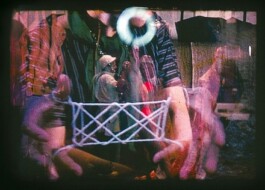
“Superimposed photographs of Mr. Fleischman’s butcher shop in New York, and the Kiowa around Anadarko, Oklahoma–with Cognate Material. The trip is dark at the beginning and end, light in the middle, and is structured 122333221. I honour it the most of my films, otherwise a not very popular one before 1972. If the exciter lamp blows, play Bert Brecht’s Mahogany”. (Harry Smith)
MEREDITH MONK & ROBERT WITHERS, SHIRLEY CLARKE, MARIE MENKEN, MAYA DEREN
27 June 2023
The eighth event of 16MM RUN focuses on five films made in close collaboration between music and performance and directed by central figures in the art and film scene of the last century: Meredith Monk and Robert Withers (16 Millimeter Earrings, 1979; Turtle Dreams, 1981), Shirley Clarke (Bridges Go Round, 1958), Marie Menken (Arabesque for Kenneth Anger, 1961), Maya Deren (The Very Eye of Night, 1959).
Meredith Monk and Robert Withers, 16 Millimeter Earrings, 1979, 25'
Courtesy Robert Whiters, Meredith Monk and NACG/FMC
In 1966, Meredith Monk performed 16 Millimeter Earrings for the first time. She not only choreographed the movement, but also wrote the soundtrack and designed several short film sequences projected during the performance. Robert Withers' film version of 16 Millimeter Earrings documents the reconstruction of the original performance, using most of the original film sequences and sound tapes. With a different arrangement of the score composed by Monk, Withers' filmic interpretation creates a different juxtaposition of sound and image than the original, while still capturing the essence of this seminal work.
Meredith Monk and Robert Withers, Turtle Dreams, 1981, 11'
Courtesy Robert Whiters, Meredith Monk and NACG/FMC
In what initially appears to be a documentary, a turtle emerges from a primeval forest only to find itself traversing a map of the world and end up strolling undisturbed through the desolate streets of a miniature ghost town. Originally produced as a silent film to accompany the performance of Monk's album of the same name, recorded in 1983, Turtle Dreams was directed by Robert Withers.
Shirley Clarke, Bridges Go Round, 1958, 7'
Courtesy Shirley Clarke estate and NACG/FMC
An evocative urban symphony by Shirley Clarke depicting the bridges of New York as a kaleidoscopic succession of vivid abstract images. The film was produced in two versions: the first with electronic music by pioneers Louis and Bebe Barron, the second with jazz composition by Teo Macero, producer-composer of Miles Davis and Charles Mingus. Clarke loved both versions, which were often shown at the same screening: 'It's a wonderful way to watch the film because you can see how the sound changes the content'.
Marie Menken, Arabesque for Kenneth Anger, 1961, 4'
Courtesy Marie Menken estate and NACG/FMC
While traveling through Spain with fellow filmmaker Kenneth Anger in 1958, Marie Menken shot Arabesque for Kenneth Anger in a single day in the gardens of the Alhambra in Granada; a work that remained unfinished and rediscovered only in 2003. Later she added composer Teiji Ito’s soundtrack of classical guitar, castanets, and hand clapping; the percussive rhythm intensifies the alternating flashes of graphic patterning and long panning shots that trace the Moorish buildings’ ornate curvature. Menken’s experimentation with movement was innovative, the filmmaker Stan Brakhage recounted: “This is one of the first films that took full advantage of the enormous freedom of the hand-held camera. In the history of cinema up to that time, Marie’s was the most free-floating hand-held camera short of newsreel catastrophe shots.”
Maya Deren, The Very Eye of Night, 1959, 15'
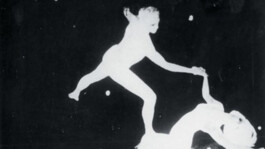
Courtesy Maya Deren estate and NACG/FMC
The Very Eye of Night was Maya Deren's last film and the longest and most expensive of her career. Filming began in 1952 but the film was completed seven years later, in 1955. The work, made in collaboration with choreographer Antony Tudor, was only released in 1959 with the addition of a soundtrack composed by Teiji Ito. Alternating in a nocturnal choreography, an effect Deren achieved by printing the whole film in negative, the students of the Metropolitan Opera Ballet School in New York float in space like dancing cosmic figures. The Very Eye of the Night is in effect a metaphysical visual poem, an ethereal dance focused on spectacle rather than narrative.
JONATHAN MONK
4 May 2023
BITS & PIECES PUT TOGETHER TO PRESENT A SEMBLANCE OF A WHOLE, 2023, 25'
Jonathan Monk, scan of 16mm film The Silent Tornado - For Jack Goldstein, 2003. Courtesy Jonathan Monk Studio
Protagonist of the seventh event of 16MM RUN is Jonathan Monk (1969), who will present a new work created for the occasion. Monk is a Berlin-based British artist whose work includes a wide range of media including installations, photography, film, sculpture and performance. His artistic practice often recalls procedural approaches typical of Conceptual and Minimalist strategies of the 1960s and 1970s grounding his conceptual approach with a personal and humorous twist often related to his personal history. Much of his work is gently playful demystifying the creative process and suggesting alternative models for how art and the role of the artist can be re-interpreted.
In the early 2000's Monk made a series of short animation films starting from a selection of artist's books, part of his personal collection, among which are books by Sol LeWitt, Richard Long and Gilbert & George.
His experimentation with film deals both with the weight of the film camera and the durational element of film itself. For this occasion the artist will present one longer film created from a series of his shorter animations, using rough cuts, fast tempos and eccentric rhythms. The title references a work by Lawrence Weiner made in 2005.
BABETTE MANGOLTE
23 February 2023
What Maisie Knew, 1975, 55'
Still from Babette Mangolte’s What Maisie Knew, 1975. Courtesy the artist and New American Cinema Group
Babette Mangolte (1941) is a French-American filmmaker, photographer and writer. Her work has been influenced by the performance and dance scene in New York in the 1970s, working very closely with Trisha Brown and Yvonne Rainer. In an interview, talking about her film Water Motor, Yvonne Rainer said “it was one of the best dance films ever made”. Mangolte has been the director of photography for the seminal works of Chantal Akerman and the filmmaker of Marina Abramovic’s Seven Easy Pieces (2007). Her work around performance is about how you look at what you see and how being a spectator is at the core of performance as an art form.
Most of Babette Mangolte’s early work in film, as well as photography, is a self-examination of what it means to be a spectator. Her first narrative film, What Maisie Knew (1975), is made around the subjective camera, the vision of a child, and a re-reading of the Henry James novel. In this work one can observe Mangolte’s references on dance and performance, but the film is also an experiment in narrative filmmaking: it has practically no dialogue, and is made of set situations that repeat, evolve and change featuring among others Kate Manheim, Yvonne Rainer, Jerry Bauman and Philip Glass.
Immediately one can see the interest for Mangolte in this 1897 novel whose heroine is depicted like this by James: “She was taken into the confidence of passions on which she fixed just the stare she might have had for images bounding across the wall in the slide of a magic lantern. Her little world was phantasmagoric – strange shadows dancing on a sheet. It was as if the whole performance had been given for her – a mite of a half-sacred infant in a great dim theatre”. Through the book Maisie is both spectator and screen. She survives the family turmoil by becoming a blank surface on which anyone can see what they want, project what they want.
The film is shot from the point of view of a child but we never see the child. The child is what the film camera sees.
“I felt that the subjectivity of the child permitted me to be looking at something with the kind of astonished bewilderment of someone that doesn’t understand what they were looking at. At first you have the sense that somebody is called Maisie, and at the end you understand that Maisie is a child, in the last scene she is hiding in the closet. The closet door is shut and that is the end.”
ALFREDO LEONARDI
8 October 2022, 7pm
On the occasion of the Giornata del Contemporaneo, Villa Lontana in collaboration with MACRO will screen a series of short films related to the city of Rome by Italian director, producer and photographer Alfredo Leonardi (Voghera, 1938): Libro di Santi di Roma Eterna, 1968, 14'; Le N ragazze più belle di piazza Navona, 1968, 11'; Organum Multiplum, 1967, 14'; Living & Glorious, 1965, 20'.
Alfredo Leonardi is considered one of the protagonists of Italian underground cinema. In the 1960s he collaborated with the Italian Living Theatre. From 1964 he devoted himself to experimental cinema: Living & Glorious (1965) and Se l’inconscio si ribella (1968) were his best-known short films, while Amore, amore (1966), the only full-length film ever made, of which Leonardi personally directed and edited, premiered at the Pesaro Film Festival in 1967. From the 1970s he worked for television and at the same time produced and directed documentary films such as Policlinico in lotta (1973) and Carcere in Italia (1973). His sensitivity for social issues also emerges in the following Lottando la vita – Lavoratori italiani a Berlino (1975).
Alfredo Leonardi always considered himself as a poet of film instead of a narrator, constructing his images in a poetic way. For Leonardi seeing is a way of thinking, his filming is fragmentary and instinctive. In an interview with Valentino Zeichen and Paolo Brunatto, Leonardi affirms to feel extremely connected with the God Apollo. In Ancient Rome, the 7th of each month was sacred to the god. Leonardi was born on 7 September and this - for him - is a natural Apollonian component that he feels deeply connected to, also defining his aesthetic approach to film.
JAMES BENNING
27 May 2022
11 x 14 by James Benning, 1976, 83'
Courtesy Canyon Cinema, San Francisco
The fourth event presents a screening of 11 x 14 shot in 1976 by James Benning, establishing him as an important contributor to American independent cinema and as a representative of the “New Narrative Movement”. 11 x 14 is Benning’s first feature-length film announcing the arrival of a radical new voice in the evolution of moving image art, and remains a landmark of the American avant-garde. Composed of 65 beautifully framed shots of provincial life and suburban domesticity, this 16mm-shot travelogue of the Midwestern United States advanced notions of structuralist cinema while forming a visual tapestry of the American heartland in all its rugged glory.
The film captures the iconography of this region through repeated images and sounds of trucks and interstate highways, billboards and elevated trains, and silos and bales of hay. Protagonists frequently interact in the background of the image and their dialogue is deliberately muffled so that their motivations are obscured. 11 x 14 points toward the creation of a new, nonliterary but populist cinema.
In films like 11 x 14 and One Way Boogie Woogie, Benning combines the structural analysis of image, sound and narrative with auto-biographical traces, as well as with an almost “classical” interest in composition, color, light and landscape.
The places in Benning’s early films were midwestern, he himself grew up in Milwaukee; this gave notice that the so-called cinematic flyover zone—the territory between the centers of film production in New York and California—could not only be the focus of interesting work but nurtured an important avant-garde filmmaker. Later, Benning would move to New York City and then on to California (where he began teaching at CalArts in 1987), expanding his horizons while continuing to make a film every year or two. Given the considerable body of work he has created and the intense focus on place in so many of his best films—including 13 Lakes (2004), Ten Skies (2004), and RR (2007)—it now seems fair to say that Benning has become the foremost filmmaker of the American landscape.
His work has always been challenging. 11 x 14 and One Way Boogie Woogie were made in the aftermath of Andy Warhol’s long slow films and of the “structural films” that followed. Warhol and Michael Snow, Ken Jacobs, Ernie Gehr, J. J. Murphy, and others used extended duration and repetitive structures to contest not only the commercial cinema and its reliance on conventional narrative but also the various forms of personally expressive cinema that had dominated the 1950s and early ’60s film avant-garde—most obviously, the work of Stan Brakhage, Kenneth Anger, and Jack Smith. Benning’s roots in structural film have remained evident throughout his career and have informed his filmmaking in a variety of ways.
JOSÉ RODRÍGUEZ-SOLTERO
29 April 2022
Lupe by José Rodríguez-Soltero, 1966, 49'
Courtesy of The Film-Makers' Cooperative, New York
The third event presents a screening of José Rodríguez-Soltero’s Lupe (1966), an underground classic of the stature of Flaming Creatures, Scorpio Rising, Hold me While I’m Naked, or The Chelsea Girls.
Strangely neglected for way too long, the film is ostensibly a biopic of Lupe Velez inspired by Kenneth Anger’s sketch of the “Mexican spitfire” in Hollywood Babylon and, stylistically, by Von Sternberg’s Marlene Dietrich vehicles.
Rodríguez-Soltero takes some liberties with the facts and produces a color-saturated, gorgeous dime-store baroque that tells of Lupe’s rise from whoredom to stardom, her fall into fractured romance and suicide, and her ascension into the spirit world. It is consistently inventive and surprising, and wrapped in a dense soundtrack that combines, Elvis, Cuban boleros, Spanish flamenco, The Supremes, and Vivaldi. It features some of the main players of the Ridiculous Theatrical Playhouse (Charles Ludlam plays a keen lesbian seducer and Lola Pashalinsky, Lupe’s maid). Mario Montez never looked better; no wonder this was his favorite film. Whether they know it or not, Pedro Almodavar, Vivienne Dick, and Bruce LaBruce have a grandfather in Jose Rodriguez Soltero. –Juan Suarez.
JACK SMITH
18 February 2022
Normal Love by Jack Smith, 1963, 120'
Courtesy of Jack Smith Archive and Gladstone Gallery, New York and Brussels
The event appointment of the programme offers a screening of the experimental film project Normal Love, shot in 1963 by the American filmmaker and artist Jack Smith (1932 – 1989), an unconventional artist who provocatively spanned the territory between the world of Hollywood and underground culture.
Made by Smith after the censorship of his film Flaming Creatures, which caused scandal due to its sexual content, Normal Love is a highly experimental work whose production was supported by Jonas Mekas. The film became a source of inspiration for other creators such as Federico Fellini, who mentioned it as an influence on his Satyricon.
Taking the genre of horror films from the 1930s and 1940s as a reference point, Smith set Normal Love in a fantasy world, an Atlantis packed with pink and green pastel hues. “Rubens. Arabian Nights. Chinese masters. Monet”, Mekas remarked after seeing the first rushes.
Shot on elaborate, evocative and dreamy sets, including a giant cake designed by the artist Claes Oldenburg, Normal Love is a riotous combination of Dionysian debauchery and kitsch horror. In the universe of Normal Love we see a variety of exotic creatures, portrayed by personalities and friends from the artist’s entourage, in a sort of “fantasy-reality” that captures freedom of imagination: from the mermaid played by Mario Montez, whose stage name is a tribute to the Dominican actress Maria Montez, to the mummy played by Angus MacLise, drummer of the Velvet Underground. The cast of the film, in addition to Smith as a magician, includes Diana Bacchus, David Sachs, Beverly Grant, Naomi Levie, Francis Francine, Tony Conrad, Tiny Tim, Sheila Bick, Eliot Cukor, John Vaccaro, John Adler, Diane Di Prima, Arnold Rockwood, Teddy Howard, Johnny Foster, Stanley Alboum, Alain Marlowe, Pat Oldenburg e Andy Warhol.
The film was left intentionally unfinished by the artist: its editing was left open as an act of rebellion against the commodification of art, preventing any form of censorship. Smith showed the film in different forms, often in performative screenings that required his presence, during which he varied the musical accompaniment, utilizing records from his collection.
STORM DE HIRSCH – CAROLEE SCHNEEMANN
17 December 2021
The 16MM RUN programme begins on December 17 with the screening of four short films of two essential female figures in the artistic and cinematographic panorama of the last century. These areStorm de Hirsch and Carolee Schneemann.
Storm de Hirsch (1912-2000) was an American poet and director, a key figure in the New York avant-garde film scene of the 1960s and a founding member of the Film-Makers’ Cooperative, founded in 1962 to distribute avant-garde, experimental and underground films as an alternative to the commercial films on view at the time. Her work has a strong abstract component and makes use of experimental and sophisticated composition techniques.
Carolee Schneemann (1939-2019) was an American artist active in the fields of performance, body art and video. Using the body as the prevalent material of her art, she situates women as both the creator and an active part of the creation itself, with a strong feminist imprint that refused the idea of body as an object, considering it instead as a primal, archaic force which could unify energies. Her work is direct, sexual, liberating and autobiographical. Through painting, filmmaking, video art and performance, Schneemann re-writes her personal history of art, refusing the idea of an “his-tory” narrated exclusively from the male point of view.
Below are the films scheduled for the first screening:
Divinations by Storm de Hirsch, 1964, 10'
Divinations is the first chapter of Storm de Hirsch’s 1960s trilogy, The Color of Ritual, the Color of Thought. In an interview with Jonas Mekas in which she reflects on the making of Divinations, Storm de Hirsch said: “I wanted badly to make an animated short and had no camera available. I did have some old, unused film stock and several rolls of 16mm sound tape. So I used that—plus a variety of discarded surgical instruments and the sharp edge of a screwdriver—by cutting, etching, and painting directly on both film and [sound] tape”. The result is a hallucinatory, dizzying, and meditative collage of image and sound which attests the artist’s interest in form, color, and process, as well as myth, ritual, and mysticism.
Peyote Queen by Storm de Hirsch, 1965, 10'
Peyote Queen is the second and best-known chapter of the trilogy The Color of Ritual, the Color of Thought. Conceived as a journey through the underworld of sensory derangement, the film’s imagery is abstract, consisting of both live action footage and animated sequences which de Hirsch created by painting and etching directly on the 16mm film stock. Split screens, kaleidoscopic lenses, and abstract animations are used to create a psychedelic effect. The soundtrack consists of African drumming and singing interspersed with American pop music.
In 1963 the US government imposed the legendary Living Theatre in New York to close after missed tax payments during the run of their controversial production The Brig. Jonas Mekas decided to make a film of the production to preserve its brilliance and in-depth dynamism. This took place one night when actors and the rest of the crew broke into the locked theatre which still had inside it all of its confiscated materials. It was on this occasion that Storm De Hirsch made this short newsreel: not only was she able to capture a study of Mekas while he was filming, but she also captured a tension and apprehension of the moment, as well as a sense of panic at the possibility of not being able to finish the film.
This is a silent film of collaged and painted sequences of lovemaking between Schneemann and her then partner, composer James Tenney, from the point of view of her/their cat, Kitch. Her attempt was to reproduce the whole visual and tactile experience of sex as a subjective phenomenon: “I wanted to see if the experience of what I saw would have any correspondence to what I felt, the intimacy of the lovemaking… And I wanted to put into that materiality of film the energies of the body, so that the film itself dissolves and recombines and is transparent and dense, as one feels during lovemaking… It is different from any pornographic work that you’ve ever seen, that’s why people are still looking at it! And there’s no objectification or fetishization of the woman”.
The screenings take place in the Sala Cinema at MACRO. Entry at Via Nizza, 138 ― 00198, Rome. No booking required. Free entrance until capacity reached.
With the support of Fondazione Dino ed Ernesta Santarelli.
16MM RUN is an experimental film programme in collaboration with MACRO conceived to present a selection of authors and titles out of the mainstream circuits, not easily available or that have rarely been screened in Italy. The programme includes mostly avant-garde and experimental films from the ‘60s, ‘70s and ‘80s without following a specific thematic focus. It is a hymn to the physicality of film in a time driven by digital. The programme took place between December 2021 — December 2024 at the Sala Cinema at MACRO. With the support of Fondazione Dino ed Ernesta Santarelli.
EDWARD OWENS, TAYLOR MEAD
10 December 2024
16MM RUN concludes on Tuesday, December 10, with Tomorrow’s Promise (1967, 44') by Edward Owens (1949–2010) and Home Movies Rome/Florence/Venice/Greece (1965, 14') and Home Movies N.Y.C. to San Diego (1968, 19') by Taylor Mead (1924–2013) — two filmmakers who challenged traditional formal and narrative conventions, crafting personal visual languages centered on the concept of travel.
The event, which marks the conclusion of the program that began in 2021, will feature Marco Giusti, film critic, essayist, television writer and director, for a conversation with Luca Lo Pinto and Vittoria Bonifati on the role of analog experimental cinema in the contemporary cultural landscape.
On this occasion, a limited edition collection will be presented, gathering the films that have been part of 16MM RUN: from the beginning of the series with Storm de Hirsch and Carolee Schneemann to today with Edward Owens and Taylor Mead, passing through Jack Smith, Maya Deren, and many others. Together, these films form a significant archive of experimental cinema from the ’60s, ’70s, and ’80s.
Edward Owens (1949–2009) was a queer African-American filmmaker who was involved with the New American Cinema of the 1960s. He is best known for his experimental films Remembrance: A Portrait Study (1967) and Private Imaginings and Narrative Facts (1968-70). When he moved to New York City as a young man, Owens was hired by Jonas Mekas to work at the Film-makers’ Cinemateque. When Mekas saw Owens’ films he was invited to join the FMC for distribution as a part of the New American Cineam movement. In 2016, Executive Director MM Serra collaborated with IndieCollect to preserve the four Owens films within the NACG collection through a 5k digital scanning process. The digital transfer was supervised by NACG’s digital media specialist Sheldon Henderson.
Taylor Mead (1924–2013) was born in Detroit, Michigan and raised by divorced parents mostly in the wealthy suburb of Grosse Pointe. He appeared in Ron Rice’s beat classic The Flower Thief (1960), in which he “traipses with an elfin glee through a lost San Francisco of smoke-stuffed North Beach cafes.. .” Film critic P. Adams Sitney called The Flower Thief “the purest expression of the Beat sensibility in cinema.” Village Voice film critic J. Hoberman called Mead “the first underground movie star.”In 1967 Taylor Mead played a part in the surrealistic play Desire Caught by the Tail by Pablo Picasso when it was set for the first time in France at a festival in Saint-Tropez, among others with Ultra Violet. In the mid-1970s, Gary Weis made some short films of Mead talking to his cat in the kitchen of his Ludlow Street apartment on Manhattan’s Lower East Side called Taylor Mead’s Cat. One film of Mead extemporizing on the virtues of constant television watching aired during the second season of Saturday Night Live. In 1995 Mead spent eight hours a day for a week at the Bon Temps bar, New Orleans, being documented in the photobooth costumed as a series of Warholian characters for Blake Nelson Boyd’s documentary Photobooth Trilogy. Characters included Superman and Mickey Mouse from Warhol’s Myth series and references to Mead’s performances in Lonesome Cowboys and Nude Restaurant. While living on Ludlow Street, Mead read his poetry regularly at The Bowery Poetry Club. His First book of poems Taylor Mead on Amphetamines and in Europe was written in 1968. His last book of poems is called A Simple Country Girl. He was the subject of a documentary entitled Excavating Taylor Mead, by Jim Jarmusch which debuted at the Tribeca Film Festival in 2005. The film shows him engaging in his nightly habit of feeding stray cats in an East Village cemetery after bar-hopping, and features a cameo by Jim Jarmusch, in which Jarmusch explains that once, when Mead went to Europe, he enlisted Jarmusch’s brother to feed the cemetery cats in Mead’s absence. Mead appeared in the final segment of Jarmusch’s 2003 film Coffee and Cigarettes. He has been “a beloved icon of the downtown New York art scene since the 60s.”
Edward Owens, Tomorrow’s Promise, 1967, 44'75''

With Tomorrow’s Promise, Edward Owens explores existential void, identity, and introspection, combining intimate portraits, evocative imagery, and technically complex editing. The film carries a strong emotional charge, enhanced by the use of color and visual structure, which seem to suggest a shifting mood and an inner journey.
«Tomorrow’s Promise is a film about vacantness. Which physically does ‘begin’, reversed, upside down on the screen (but by what premise is it supported? , e.g. the film, so chimerical as life itself, follows its own way), suddenly another such position is taken (not in reverse), this time by a male figure and soon, in this same section, the girl of the reversed image reappears posed in a different way; a way obsessed by ‘mood’. Then a technical play of in-the-camera-editing occurs, more intense, brighter than in the first, reversed section. There are several inter-cuts which serve, in this and each subsequent section unto the end, as relative links into the final section: which is actually the ‘story’. The story the protagonist and her hero try to tell in their way is apophysis; except that ‘pictures’, clear visions take the place of words. My film could have been edited with precise tensions and a lucid straight narrative, but it was my aim to ‘re-create’ the protagonist of my personal life.» – Edward Owens
Taylor Mead, Home Movies
«My home movies which weigh 2 pounds so far began in Mexico City where I got bored and bought a 50-ft. Keystone at National Pawn Shop-I was immediately turned on-to the City, to Mexico-it really makes a difference-and in 16mm-but I wanted to shoot in color and it costs about 10 dollars/50 ft. in Mexico so I had to push single frame button much of the time-oh me, but its lovely anyway-I kept pushing once I crossed border into U.S. and N.Y. and Malibu. » Taylor Mead
Taylor Mead, Home Movies – Rome/Florence/Venice/Greece, 1965, 14'

The film follows the author on a journey through some of the most iconic cities in Italy and Greece, including Rome, Florence, Venice, and various locations in Greece. Shot with a handheld video camera in an amateur and spontaneous style, the footage captures the essence of the 1960s “do-it-yourself” tourism, alternating between moments of Mead’s typical lightheartedness and irreverence and evocative images of the historic and cultural places visited. The combination of majestic settings and informal cinematography creates a personal and intimate account of a trip through Europe, with a laid-back and unconventional approach that reflects the free-spirited nature of the cinematic avant-garde of that time.
Taylor Mead, Home Movies / N.Y.C. to San Diego, 1968, 19'

The film documents a journey starting from New York City and ending in San Diego, capturing fragments of daily life and random moments along the way. Shot in the amateur style typical of home videos, Mead uses a handheld camera to film spontaneous scenes, landscapes, and people encountered during the trip. The film reflects Mead’s experimental aesthetic and anarchic spirit, characterized by a free, unscripted approach. Without dialogue or a soundtrack, the short focuses on the images, presenting a visual journey through 1960s America with a sense of creative freedom and personal exploration.
KEIICHI TANAAMI
15 November 2024
Keiichi Tanaami (Tokyo, 1936-2024) actively crosses the boundaries between different artistic practices with his eclectic work as art director, graphic designer, illustrator, videographer and artist, and is today considered a role model for the current generation of interdisciplinary artists. Employing the design methodology of ‘editing,’ he has always engaged in a creative practice that extends beyond the framework of fine art, producing a diverse oeuvre ranging from collages to prints, drawings, animation, experimental films, paintings, three-dimensional works, and installations. He is widely recognized internationally as a Japanese pioneer in the ever-expanding context of pop art.
Tanaami’s recent solo exhibitions include Adventures in Memory (The National Art Center, Tokyo, 2024), PARAVENTI: KEIICHI TANAAMI (Prada Aoyama, Tokyo, Japan, 2023), Manhattan Universe (Venus Over Manhattan, New York, USA, 2022), A Mirror of the World (NANZUKA UNDERGROUND, Tokyo, Japan, 2022), Keiichi Tanaami (Kunstmuseum Luzern, Luzern, Switzerland, 2019), Keiichi Tanaami (Jeffrey Deitch, New York, 2019). He has also participated in major pop art retrospectives such as International Pop (Walker Art Center, Dallas Museum of Art, Philadelphia Museum of Art, USA, 2015-2016) and The World Goes Pop (Tate Modern, London, UK, 2015). Tanaami’s works are housed in numerous public collections including The Museum of Modern Art [MoMA] (USA), Walker Art Center (USA), The Art Institute of Chicago (USA), M+ (Hong Kong), National Portrait Gallery (USA), Hamburger Bahnhof (Germany).
Marionettes in Masks, 1965, 8'

Courtesy the artist and Nanzuka
This animated film, along with A Portrait of Keiichi Tanaami released the following year, focuses on the themes of face and identity. Tanaami viewed the myriad faces seen daily in the media as interchangeable “masks,” and presented them as symbolic representations of contemporary life. The marionettes in various masks embody a spectrum of personas, in styles ranging from painterly strokes to American comic-style illustrations. However, the marionettes ultimately collapse, overwhelmed by the dizzying speed of the information deluge. The direct influence of Pop Art on these motifs points to the artist’s desire to integrate new art movements into animation.
Commercial War, 1971, 4'30''

Courtesy the artist and Nanzuka
Following a countdown, six sequences unfold in succession. Visual elements from ads for Coca-Cola, hamburgers, and cosmetics are combined with audio clips from Japanese TV commercials. These juxtapositions generate a pronounced sensation of cognitive dissonance, and removed from their original advertising contexts, the images and words take on a satirical tone. The first sequence in particular includes sporadic audio fragments that evoke a parliamentary debate, conveying an ironic take on the relentless flood of images and information disseminated by television and the emptiness of political rhetoric. In the final scene, a photograph of a crowd with indistinct faces is paired with dialogue that might be interpreted as critiquing the public itself.
Good-by Elvis and USA, 1971, 7'3''

Courtesy the artist and Nanzuka
As in Good-by Marilyn, Tanaami’s method of appropriating American pop culture while infusing it with his own sensibility is apparent in this animated film. It presents a series of moving images superimposed in collage-style, including photographs of movie stars like Elvis Presley and Marlon Brando as well as Tanaami’s frequently recurring motifs of erotic illustrations and fighter planes. Tanaami first visited the United States in 1970, and recalled that he avidly acquired inexpensive popular magazines there. Photographs and a magazine cover, dated January 1971, included in this work hint at his personal experiences in the U.S.
Good by Marilyn, 1971, 4'25''

Courtesy the artist and Nanzuka
This is one of the animated films Tanaami produced for the television program 11PM. It deploys reiterated eroticized motifs such as hot dogs, bananas, and pornographic cutouts intermingled with depictions of Marilyn Monroe wearing the Statue of Liberty’s crown as well as various Disney-style characters, creating a lively and rhythmic visual flow. Symbols of American pop culture are interwoven with Japanese cultural elements, such as the famous Glico sign in Osaka’s Dotonbori district and background music featuring the singing of Miki Hirayama. The inclusion of fighter planes and the Vietnamese flag, evoking war, further integrates disparate elements into Tanaami’s signature visual vocabulary.
Study of the Virgin in School Uniform Stripped Bare by Her Bachelors, 1972, 3'45''

Courtesy the artist and Nanzuka
This work is clearly influenced by Marcel Duchamp’s “The Bride Stripped Bare by Her Bachelors, Even” (commonly known as “The Large Glass”), with a title that references Duchamp’s ironic approach to art. Keiichi Tanaami uses Duchamp’s work as a foundation to satirize Japan’s art scene at the time, filtering it through his own unique perspective. When this piece was released in the early 1970s, Japan’s artists were witnessing the waning of avant-garde energy, as they were increasingly being drawn into national projects in the midst of rapid economic growth. Within this context, Tanaami’s work, influenced by the psychedelic culture of the 1960s and Neo-Dada, boldly explores experimental expression through the medium of film.
Oh Yoko, 1973, 5'

Courtesy the artist and Nanzuka
Set to John Lennon’s 1971 song “Oh Yoko!,” this animated film interweaves illustrations and photographs of Lennon and Yoko Ono with trademark Tanaami motifs such as insects and airplanes. It also features many elements associated with the Beatles, including submarines, strawberry fields, and the elephant-headed Hindu deity Ganesh. Vivid colors and shapes reminiscent of the animation in the 1968 Beatles film Yellow Submarine permeate the work, illustrating Tanaami’s active integration of influences from the counterculture of the day.
Crayon Angel, 1975, 3'

Courtesy the artist and Nanzuka
This film represents a shift away from the vibrant Pop motifs that characterized Tanaami’s 1960s work and toward more intense wartime imagery. Motifs such as a woman blasted by a shockwave and chickens squawking in terror at the sound of air-raid sirens are drawn from his actual memories. Images of prewar comedians like Ken’ichi Enomoto laughing and photographs from Tanaami’s youth are seen through a grid-like filter, conveying the distance between the adult Tanaami and his childhood memories. The continuous heartbeat sound heard throughout the piece emphasizes the introspective nature of the work, which enables viewers to vicariously share Tanaami’s exploration of deep memory layers.
Sweet Friday, 1975, 3'17''

Courtesy the artist and Nanzuka
This animated film depicts morning on Tanaami’s favorite day of the week, Friday, set to light-hearted music. It follows his waking routine of washing his face, wiping his glasses, eating breakfast, and taking a shower. Various scenes from his imagination are interspersed among these daily actions with a flicker effect that evokes experimental films. Images include a sparrow he projected with a magic lantern as a child, goldfish his grandfather kept during World War II, and white female nudes, all juxtaposed without apparent connection, reflecting a morning mental state of interplay between the fantastical and the mundane. The inclusion of a letter and photographs from his close friend Ushio Shinohara offers a glimpse into Tanaami’s actual personal life. out the piece emphasizes the introspective nature of the work, which enables viewers to vicariously share Tanaami’s exploration of deep memory layers.
Why, 1975, 10'

Courtesy the artist and Nanzuka
Around this time Tanaami began integrating printing techniques into his film production, inspired by the reading of a newspaper article the morning after a Muhammad Ali fight. He was struck by the coarse, gritty texture of the printed photo, which to him conveyed greater immediacy and impact than television footage, and began exploring this tactile quality in his works. This particular work was driven by interest in the visual effects of enlarging and animating the halftone dots of newspaper and magazine photographs. In the film, enlarged dots gradually decrease in size, ultimately revealing a scene of a boxing match. The boxers’ clumsy movements, accompanied by sporadically off-key piano, showcase Tanaami’s whimsical sense of humor.
Trip, 2005, 5'

Courtesy the artist and Nanzuka
A visionary animation collaboratively crafted by Keiichi Tanaami and Nobuhiro Aihara, two iconic figures in the realm of Japanese experimental cinema. This film delves into the psychedelic and surrealistic visual language both artists are renowned for, offering a vivid journey through the subconscious. Melding fluid, hand-drawn animation with vibrant and disorienting imagery, Trip encapsulates the chaotic interplay of dreams and memories.
Chirico, 2008, 4'30''

Courtesy the artist and Nanzuka
This film is inspired by the paintings of Giorgio de Chirico: his paintings seemed to Tanaami like frozen instants within sequences of images, and he felt the urge to make them move through animation. The film starts with a scene from de Chirico’s Mystery and Melancholy of a Street (1914) in which a girl pushes a hoop. We then see de Chirico’s self-portrait merge with a faceless mannequin, and a surrealistic world based on the metaphysical painter’s style. Through the creative synergy of Tanaami and Nobuhiro Aihara, static images from de Chirico’s paintings are woven into a vibrant animated narrative.
BARBARA HAMMER, BETTE GORDON
23 October 2024
Feminist filmmaker and pioneer of queer cinema, Barbara Hammer (1939-2019) made over 90 moving image works as well as performances, installations, photographs, collages and drawings. In the early 1970s Hammer studied film at San Francisco State University. After seeing Maya Deren’s film Meshes of the Afternoon, she was inspired to make experimental films about her personal life. After coming out as a lesbian she “took off on a motorcycle with a super-8 camera” and in 1974 filmed Dyketactics, widely considered to be one of the first lesbian films. Hammer sought to deconstruct and disempower the narratives and structures that oppress women in general and lesbians in particular. From her earliest experimental work, her films are playfully and relentlessly challenging accepted norms and taboos. In the last decade of her life, Hammer was given retrospective exhibitions in several internationally major museums and in 2017 her paper archive was acquired by the Beinecke Rare Book and Manuscript Library at Yale University. Hammer also established the Barbara Hammer Lesbian Experimental Filmmaking Grant—awarding the first grant in 2017.
Bette Gordon (1950, USA), a pioneer in the American Independent Film world, is best known for her bold explorations of themes related to sexuality. Her early short films, most notably Empty Suitcases, won numerous awards and Festival acclaim worldwide, including showings at the Berlin International Film Festival, New York’s Museum of Modern Art and The Whitney Biennial. Variety (1984) marked her debut as a feature film director, particularly in light of the film’s invitational showing at The Cannes Film Festival’s Director’s Fortnight. Bette Gordon has collaborated extensively with James Benning in the '70s on films such as The United States of America (1975), Michigan Avenue (1973) and i-94 (1974). Gordon holds a BA, MA, and MFA from The University of Wisconsin – Madison and is now a part of the film department of Columbia University School of the Arts. Some of her films are now part of permanent collections in several different museums including the Museum of Modern Art and the Whitney Museum of American Art.
Women I Love, 1976, 22′39′′

Women I Love is a series of cameo portraits of the filmmaker’s friends and lovers intercut with a playful celebration of fruits and vegetables in nature. Culminating footage evokes a tantric painting of sexuality sustained. Each lover is compared with a colorful flower, or a fruit or vegetable peeling open from its core in animated pixelation. Using double-exposure, out-of-date stock, the relationships are portrayed with a strong sense of the romantic. The lovers’ identities are never presented; rather the women are objectified and idealized. The film form tells us much about “lesbian lifestyle”; the relationships are clearly delineated yet it seems the traces of one relationship’s failure are repeated in the next.
No No Nooky T.V., 1987, 12′

Using a 16mm Bolex and Amiga computer, Hammer creates a witty and stunning film about how women view their sexuality versus the way male images of women and sex are perceived. The impact of technology on sexuality and emotion and the sensual self is explored through computer language juxtaposed with everyday colloquial language of sex. No No Nooky T.V. confronts the feminist controversy around sexuality with electronic language, pixels and interface. Even the monitor is eroticized in this film/video hybrid that pokes fun at romance, sexuality, and love in our post-industrial age.
Empty Suitcases, 1980, 48′75′′

«Empty Suitcases is a narrative derived from film’s own material and my concern for exploring issues of representation and identification in cinema. The film presents fragments of a woman’s life–her work as a photographer, her friendship and relationships; in short, her economic, sexual,and artistic struggles. By deconstructing the fragments of text, speech, music and picture, the film forces focus on the workings of narrative, as well as on the narrative itself. Central to Empty Suitcases is women’s inability to place and define themselves in language and politics, the location of radical struggle. This displacement leads to a definition of woman as other, and reveals problems of unresolved sexual relations, difference, and violence» (Bette Gordon). According to J. Hoberman (Village Voice), her most successful sequences – a militant ‘new wave’ fashion show in which models photograph themselves, an expressionless white woman lip syncing along to Billie Holliday, a scene where the filmmaker relates a dream only to be drowned out by Talking Heads singing Psycho Killer – all criticize conventional modes of representation, with particular attention to what current academic jargon calls ‘the imaging of woman’.
BRUCE CONNER
15 May 2024
Bruce Conner (1933 – 2008) is today recognized as one of the most important American artists of the 20th century, renowned for his work in film, assemblage, drawing, sculpture, painting, collage, photography, and conceptual pranks. Born in McPherson, Kansas and raised in Wichita, in 1957 he dropped out of the MFA program at the University of Colorado in Boulder and moved to San Francisco. Emerging from the California art scene, in which he worked for half a century, Conner’s work touches on various themes of postwar American society, from a rising consumer culture to the dread of nuclear apocalypse.
Conner earned a national reputation with his shocking sculpture Child (1959), a grotesque wax figure lashed to a high chair with nylon stockings and for his pioneering assemblages, which he called Rat Bastards. Between 1957 and 1964 he made nearly two hundred of these hybrid accretions of found objects bound together with nylons. For materials Conner raided junk shops and run-down Victorian houses using scavenged objects and adopting a self-consciously marginalized stance, creating sculptures inspired by installations made by local junk dealers and other store owners.
Equally a pioneer of avant-garde filmmaking, Conner turned to film with A Movie in 1958 with a freewheeling curiosity and resistance to pigeonholing that would last throughout his lifetime. He developed a quick-cut method of editing that defined his oeuvre. Incorporating footage from a variety of sources—countdown leaders, training films, and newsreels—and adding later his own 16mm film footage, Conner’s films also focus on disturbing but utterly current themes. A key figure in the Beat counterculture of the 1950s, Bruce Conner rejected bourgeois ideals of art as an expression of privileged creativity that produces a beautiful, eternal object. Instead, he challenged artists to deliver new forms based on new values—spontaneity, impurity, the degraded, and the marginal. In 1968, anxious to evade easy classification, Conner gave up his New York representation and turned increasingly to performance and conceptual art. Working fluidly in a range of media and later associating with the hippie and punk subcultures, he remained a restless maverick.
LOOKING FOR MUSHROOMS (Long version), 1959-67/1996, 16mm, color, sound, 14'

Courtesy of the Conner Family Trust / © Conner Family Trust
Looking for Mushrooms (1959-1967) is a psychedelic travelogue film that documents a series of “trips” through rural Mexico and urban America. Conner combined street views of San Francisco shot in the late 1950s with scenes of rural Oaxaca captured during his “mushroom-hunting” excursions between 1961 and 1962, when Bruce and his wife, the artist Jean Sandstedt, were living in Mexico City. On at least one of these trips, the Conners were joined by Timothy Leary, the ex-Harvard professor and soon-to-be leading proponent of psychedelic drugs. Whereas an earlier version of the film was silent and played on a loop, in 1967 Conner added a rock ’n’ roll soundtrack, The Beatles’ Tomorrow Never Knows off their 1966 album Revolver. Conner often noted that this version of Looking for Mushrooms (along with Cosmic Ray) was often rented by advertising agencies, which were presumably interested in his use of quick-cut editing and strobe effects to generate visual disorientation and subliminal messages. In 1996, Conner revised the film once again: he used an optical printer to expand its length from three to fourteen-and-a-half-minutes, and added a new soundtrack, Terry Riley's Poppy Nogood and the Phantom Band, to create a more meditative, but no less hypnotizing, iteration of the mushroom hunt.
COSMIC RAY, 1961,16mm, black/white, sound, 4'

Courtesy of the Conner Family Trust / © Conner Family Trust
Many attribute the birth of the music video to Conner's 1961 film "Cosmic Ray: a reckless collage of fast moving parts: comic strips, dancing girls, flashing lights. It is the dancing girl - hardly dressed, stripping or nude - which provides the leitmotif for the film. Again and again she appears - sandwiched between soldiers, guns, and even death in the form of a skull positioned between her legs. And if the statement equates sex with destruction, the cataclysm is a brilliant one, like an exploding firecracker, and one which ends the world with a cosmic bang. Of course, the title also refers to musician Ray Charles whose art Conner visually transcribes onto film as a potent reality, tough and penetrating in its ability to affect some pretty basic animal instincts. But if such is the content of the film - that much of our behaviour consists of bestiality - the work as a whole stands as insight rather than indictment." — Carl Belz, Film Culture. The soundtrack of the film is What'd I Say (Live from Atlanta, 1959) by Ray Charles.
BREAKAWAY, 1966,16mm, black and white, sound, 5'

Courtesy of the Conner Family Trust / © Conner Family Trust
Breakaway is a dynamic five-minute homage to the female form, counterculture, pop music, and the kinetic possibility of cinema. It is also one of the few films shot by Conner himself, rather than material found from other sources. The location was a collector’s house in Santa Monica. Conner’s friends, the actors Dean Stockwell and Dennis Hopper, held the lights, and the subject was Antonia Christina Basilotta, a young singer and choreographer, dancing and writhing frenetically to her song Breakaway, with music by Ed Cobb. The five-minute film opens with a flickering image of Basilotta posing against a black background, dressed only in a black bra and black tights into which holes have been cut. After a few seconds the music starts: the B-side of the titular single released in February 1966 under her stage name Toni Basil, a driving, high-tempo track which sets the pace for the film. Basil’s dancing is lively, but through Conner’s quick-zoom camera and stroboscopic editing it becomes almost frenetic, her underwear changing—then disappearing—in the blink of a camera’s gate. Just over two minutes into the film, as the song fades and the screen goes black, the film plays in reverse, sound and vision, from its end to its beginning. The film was shot at single frame exposures as well as 8, 16, 24 and 36 frames per second.
THE WHITE ROSE, 1967, 16mm, black/white, sound, 7'

Courtesy of the Conner Family Trust / © Conner Family Trust
In 1965, Bruce Conner filmed fellow artist Jay DeFeo and her monumental, then-unfinished artwork, The Rose (1958–66), in the moments leading up to its extraction from her San Francisco studio. In an obsessive, implacable quest, DeFeo devoted over eight years of her life to The Rose, a radiant accumulation of mica and oil paint that blurred distinctions between painting and sculpture. Prior to The Rose’s completion, DeFeo was evicted from her studio and forced to uproot her possessions and her art. Conner’s resulting film, The White Rose (1967), situates DeFeo’s masterpiece as its protagonist, documenting its forceful prying from the bay window in which it was made, as well as its journey to the sidewalk below and the moving truck that carries it away. The soundtrack of the film is Sketches of Spain by Miles Davis.
VALSE TRISTE, 1978, 16mm, sepia/sound, 5'

Courtesy of the Conner Family Trust / © Conner Family Trust
Valse Triste is a homage to surrealist cinema and a belated trance-film (the psychodramas of Maya Deren, Kenneth Anger and Sidney Peterson date from the 1940s, the time of Conner's adolescence). Autobiographical of Conner’s Kansas boyhood, the film also reworks the debased popular 'dream sequence', principally by imitating one of its cliche-prone situations—a boy's dream about steam engines, daily chores, home travel and girls. Shorn of context, ordinary images keep their typicality but gain uniqueness, mystery and the aura of memory. Beneath the period charm are disturbing ripples. Conner's imitation of the dream form is not a parody or a mockery, but it frames ironies as complex as in his other films, as deeply rooted in American social life. Each item of the collage retains something of its former identity — the footage of battered trucks, floods and the pervading melancholic mood, all evoke a very undreamlike social fact, the stubborn survival of life after a recent past of poverty and depression.
AMERICA IS WAITING, 1981, 16mm, b&w/sound, 3.5'

Courtesy of the Conner Family Trust / © Conner Family Trust
America is Waiting (1981), like Conner’s earlier films, is a compilation, a wacky assortment of bits and pieces of old newsreels, educational films, Hollywood movies, ’50s TV commercials, and hermetic fragments of industrial “film features”. Conner’s films are resurrections of sorts and, like most resurrections, there is something about them that is both ghoulish and uncanny. America is Waiting is about America, about American culture in general, and about American self-image as articulated by attitudes toward national strength, patriotism, and a vanished Golden Age of cherished national ideals. It is a film that articulates images of war, death, and disintegration in a way that pointedly challenges and subverts this legacy. The title of the film is taken from its sound track, the David Byrne/Brian Eno song from My Life in the Bush of Ghosts. The sound track cues the editing in Conner’s film, providing a running commentary on the image as a way of generating a complex of meaning and association.
A MOVIE, 1958, 16mm, black/white, sound, 12'

Courtesy of the Conner Family Trust / © Conner Family Trust
With A Movie (1958), Conner launched a lifelong celebration of moving images alongside his other artistic practices of collage, assemblage, drawing and photography. He reconceived mid-century notions of cinema itself, as A Movie simultaneously explores the very nature of cinema and montage in the modern era. Comprised of discarded 16mm films purchased at flea markets or scavenged from camera shops, A Movie has been described by many as the first contemporary “found footage film.” Conner crafted this work with care and absolute precision, qualities that would define his entire oeuvre in diverse media. A Movie orchestrates a virtual symphony of disasters, car crashes, explosions, war, famine, as well as serene moments of grace—a tightrope act, a plane floating through clouds, light reflected on water. Although seemingly random in its sequence of imagery, A Movie abstractly yet deftly moves the viewer through a wide range of human experience and emotion. With Respighi’s Pines of Rome as the soundtrack to A Movie, Conner established a visual poetry that combines music and image.
CHARLES HENRI FORD
23 April 2024
Johnny Minotaur (1971, 80’) is a film by surrealist artist and poet Charles Henri Ford. It is a lyrical explosion of taboos: incest, intergenerational desire, pansexuality and autoeroticism are a few of the issues he grapples with through mythopoeic and sensual imagery. Shot during a sojourn on Crete, the film revives the Minotaur myth in modern times and includes appearances and footage by Allen Ginsberg, Warren Sonbert, Lynne Tillman, Salvador Daliand other artists and writers who had migrated to Greece during the 1960s. Unseen for over two decades, The New American Cinema Group, Inc./The Film-Makers Cooperative has restored Johnny Minotaur and resurrected this classic of forgotten, queer cinema that belongs alongside the films of Kenneth Anger, Derek Jarman and Jean Genet.
Charles Henri Ford (1908–2002) was a surrealist poet, magazine editor, filmmaker, photographer and collage artist. He published more than a dozen collections of poetry, exhibited his artwork in Europe and the United States, co-founded and edited the Surrealist magazine View (1940-1947) and directed an experimental film. He was the co-author of the first proto-queer American novel The Young and Evil (1933); he was also part of the inner circle of Gertrude Stein in Paris in the 1930s and, in the 1960s, Ford was an important influence on Andy Warhol and New York’s literary and art communities. His oeuvre is grounded by a consistent interest in the pairing of word and image and by a tendency toward playful, twisted appropriations of the various cultural movements of which he was part.


MARIO SCHIFANO, HARRY SMITH
13 October 2023
The ninth appointment of 16MM RUN presents at the MACRO screening room a series of short films by Mario Schifano (1934-1998) and Harry Smith (1923-1991), in a face-off between two outstanding protagonists of the experimental art and film scenes of Rome and New York: Mirror Animations (1979), Late Superimpositions (1964) by Smith, and Reflex (1964), Ferreri (second half of the 1970s) and Souvenir (1967) by Schifano.
Mario Schifano was an artist, painter and filmmaker, best known as one of the fundamental figures of Pop Art in Italy. The boundaries between cinema and art were redefined by Schifano, where his use of the camera is at the same time operative tool and plastic subject. In his films there is no conception of time or narrative development, they are usually filmed diaries capturing the people, places, objects and paintings that gravitated around him, at the height of his artistic and existential creativity. “Cameras are things that have always served me to reproduce spaces and figures that I could stay with even when I was alone. […] It’s just that men are more like cinema than painting: in a film they walk, they eat, they make love, as it really happens; in painting they don’t” (Schifano).
Harry Smith was a visual artist, experimental filmmaker, record collector, bohemian, mystic, largely self-taught student of anthropology, and Neo-Gnostic bishop. Smith was an important figure in the Beat Generation scene in New York City. Besides his films, most notably his full length cutout animated film Heaven and Earth Magic (1962), Smith is also widely known for his influential Anthology of American Folk Music, drawn from his extensive collection of out-of-print commercial 78 rpm recordings, one of the most influential releases in the history of recorded sound.
Mario Schifano, Reflex, 1964, 16′

Reflex is the first experimental short film shot in America by Schifano. It is focused on the figure of the fashion photographer Bob Richardson, while portraying some models in his studio during a photoshoot (a theme similar to the one of Blow up the famous film shot by Michelangelo Antonioni two years later, in 1966). Schifano himself is also present in this film, you can see his image reflected in a mirror, holding his camera, as signified that the real focus here is on the media itself, not on the models or on the photographer. At a certain point we see one of the models taking a swig from a bottle of Coca-cola, a recurring theme in Schfiano’s oeuvre.
Mario Schifano, Ferreri, 16′

Mario Schifano was a close friend of Italian film director, screenwriter and actor Marco Ferreri, filmed here in their meetings. The film shows private images of the two artists, also featuring Mimmo Rotella and Franco Brocani.
Mario Schifano, Souvenir, 1967, 11′


In Souvenir, Mario Schifano films Peter Hartman and Gerard Malanga during their visit at the St. Peter’s Basilica in Rome. Schifano and his friends wade their way through the masses of visitors to the basilica. Their bodies and their unusual “performances” and dances form a sort of contrast to the new religion of mass tourism, which Schifano immortalizes in its most common, stereotypical – in a way pop – details. Although most of these first Schifano experimentations have no sound, in this case we can hear in the background a music and a voice (probably Malanga), reciting poems, in a sort of litany that accords well with the atmosphere of this new kind of “religion” that permeates the film. At the end of the film, the protagonist injects himself with an illicit substance on top of Gian Lorenzo Bernini’s famous colonnade. The director seems interested in drawing a parallel between the desecrating behavior of the protagonist in the holy place and the blasphemous speculation around the sale of sacred images.
Harry Smith, Mirror Animations, 1979, 11’

“If, (as many suppose), the unseen world is the real world and the world of our senses but the transient symbols of the eternal unseen, ad limiting ourselves to the aesthetic experience’s well-known predilection for the eyes and ears, we could logically propose that any one projection of a film is variant from any other. This is particularly true of Mirror Animations. Although studies for this film were made in the early 1960s, the non-existence of suitable printing equipment until recently, my inability to locate the original camera footage until 1979, and particularity, the lack of an audience ready to evaluate L. Wittgenstein’s “Ethics and Aesthetics Are One and the Same”, in the light of H.C. Agrippa’s earlier, “there is no form of madness more dangerous than that arrived at by rational means’ have all contributed to delaying until now the availability of a print in the full mirror-reverse from originally envisioned. I hope you like it.” (Harry Smith)
Harry Smith, Late Superimpositions, 1964, 31’

“Superimposed photographs of Mr. Fleischman’s butcher shop in New York, and the Kiowa around Anadarko, Oklahoma–with Cognate Material. The trip is dark at the beginning and end, light in the middle, and is structured 122333221. I honour it the most of my films, otherwise a not very popular one before 1972. If the exciter lamp blows, play Bert Brecht’s Mahogany”. (Harry Smith)
MEREDITH MONK & ROBERT WITHERS, SHIRLEY CLARKE, MARIE MENKEN, MAYA DEREN
27 June 2023
The eighth event of 16MM RUN focuses on five films made in close collaboration between music and performance and directed by central figures in the art and film scene of the last century: Meredith Monk and Robert Withers (16 Millimeter Earrings, 1979; Turtle Dreams, 1981), Shirley Clarke (Bridges Go Round, 1958), Marie Menken (Arabesque for Kenneth Anger, 1961), Maya Deren (The Very Eye of Night, 1959).
Meredith Monk and Robert Withers, 16 Millimeter Earrings, 1979, 25'
Courtesy Robert Whiters, Meredith Monk and NACG/FMC
In 1966, Meredith Monk performed 16 Millimeter Earrings for the first time. She not only choreographed the movement, but also wrote the soundtrack and designed several short film sequences projected during the performance. Robert Withers' film version of 16 Millimeter Earrings documents the reconstruction of the original performance, using most of the original film sequences and sound tapes. With a different arrangement of the score composed by Monk, Withers' filmic interpretation creates a different juxtaposition of sound and image than the original, while still capturing the essence of this seminal work.
Meredith Monk and Robert Withers, Turtle Dreams, 1981, 11'
Courtesy Robert Whiters, Meredith Monk and NACG/FMC
In what initially appears to be a documentary, a turtle emerges from a primeval forest only to find itself traversing a map of the world and end up strolling undisturbed through the desolate streets of a miniature ghost town. Originally produced as a silent film to accompany the performance of Monk's album of the same name, recorded in 1983, Turtle Dreams was directed by Robert Withers.
Shirley Clarke, Bridges Go Round, 1958, 7'
Courtesy Shirley Clarke estate and NACG/FMC
An evocative urban symphony by Shirley Clarke depicting the bridges of New York as a kaleidoscopic succession of vivid abstract images. The film was produced in two versions: the first with electronic music by pioneers Louis and Bebe Barron, the second with jazz composition by Teo Macero, producer-composer of Miles Davis and Charles Mingus. Clarke loved both versions, which were often shown at the same screening: 'It's a wonderful way to watch the film because you can see how the sound changes the content'.
Marie Menken, Arabesque for Kenneth Anger, 1961, 4'
Courtesy Marie Menken estate and NACG/FMC
While traveling through Spain with fellow filmmaker Kenneth Anger in 1958, Marie Menken shot Arabesque for Kenneth Anger in a single day in the gardens of the Alhambra in Granada; a work that remained unfinished and rediscovered only in 2003. Later she added composer Teiji Ito’s soundtrack of classical guitar, castanets, and hand clapping; the percussive rhythm intensifies the alternating flashes of graphic patterning and long panning shots that trace the Moorish buildings’ ornate curvature. Menken’s experimentation with movement was innovative, the filmmaker Stan Brakhage recounted: “This is one of the first films that took full advantage of the enormous freedom of the hand-held camera. In the history of cinema up to that time, Marie’s was the most free-floating hand-held camera short of newsreel catastrophe shots.”
Maya Deren, The Very Eye of Night, 1959, 15'
Courtesy Maya Deren estate and NACG/FMC
The Very Eye of Night was Maya Deren's last film and the longest and most expensive of her career. Filming began in 1952 but the film was completed seven years later, in 1955. The work, made in collaboration with choreographer Antony Tudor, was only released in 1959 with the addition of a soundtrack composed by Teiji Ito. Alternating in a nocturnal choreography, an effect Deren achieved by printing the whole film in negative, the students of the Metropolitan Opera Ballet School in New York float in space like dancing cosmic figures. The Very Eye of the Night is in effect a metaphysical visual poem, an ethereal dance focused on spectacle rather than narrative.
JONATHAN MONK
4 May 2023
BITS & PIECES PUT TOGETHER TO PRESENT A SEMBLANCE OF A WHOLE, 2023, 25'
Jonathan Monk, scan of 16mm film The Silent Tornado - For Jack Goldstein, 2003. Courtesy Jonathan Monk Studio
Protagonist of the seventh event of 16MM RUN is Jonathan Monk (1969), who will present a new work created for the occasion. Monk is a Berlin-based British artist whose work includes a wide range of media including installations, photography, film, sculpture and performance. His artistic practice often recalls procedural approaches typical of Conceptual and Minimalist strategies of the 1960s and 1970s grounding his conceptual approach with a personal and humorous twist often related to his personal history. Much of his work is gently playful demystifying the creative process and suggesting alternative models for how art and the role of the artist can be re-interpreted.
In the early 2000's Monk made a series of short animation films starting from a selection of artist's books, part of his personal collection, among which are books by Sol LeWitt, Richard Long and Gilbert & George.
His experimentation with film deals both with the weight of the film camera and the durational element of film itself. For this occasion the artist will present one longer film created from a series of his shorter animations, using rough cuts, fast tempos and eccentric rhythms. The title references a work by Lawrence Weiner made in 2005.
BABETTE MANGOLTE
23 February 2023
What Maisie Knew, 1975, 55'
Still from Babette Mangolte’s What Maisie Knew, 1975. Courtesy the artist and New American Cinema Group
Babette Mangolte (1941) is a French-American filmmaker, photographer and writer. Her work has been influenced by the performance and dance scene in New York in the 1970s, working very closely with Trisha Brown and Yvonne Rainer. In an interview, talking about her film Water Motor, Yvonne Rainer said “it was one of the best dance films ever made”. Mangolte has been the director of photography for the seminal works of Chantal Akerman and the filmmaker of Marina Abramovic’s Seven Easy Pieces (2007). Her work around performance is about how you look at what you see and how being a spectator is at the core of performance as an art form.
Most of Babette Mangolte’s early work in film, as well as photography, is a self-examination of what it means to be a spectator. Her first narrative film, What Maisie Knew (1975), is made around the subjective camera, the vision of a child, and a re-reading of the Henry James novel. In this work one can observe Mangolte’s references on dance and performance, but the film is also an experiment in narrative filmmaking: it has practically no dialogue, and is made of set situations that repeat, evolve and change featuring among others Kate Manheim, Yvonne Rainer, Jerry Bauman and Philip Glass.
Immediately one can see the interest for Mangolte in this 1897 novel whose heroine is depicted like this by James: “She was taken into the confidence of passions on which she fixed just the stare she might have had for images bounding across the wall in the slide of a magic lantern. Her little world was phantasmagoric – strange shadows dancing on a sheet. It was as if the whole performance had been given for her – a mite of a half-sacred infant in a great dim theatre”. Through the book Maisie is both spectator and screen. She survives the family turmoil by becoming a blank surface on which anyone can see what they want, project what they want.
The film is shot from the point of view of a child but we never see the child. The child is what the film camera sees.
“I felt that the subjectivity of the child permitted me to be looking at something with the kind of astonished bewilderment of someone that doesn’t understand what they were looking at. At first you have the sense that somebody is called Maisie, and at the end you understand that Maisie is a child, in the last scene she is hiding in the closet. The closet door is shut and that is the end.”
Archive:
STORM DE HIRSCH
CAROLEE SCHNEEMANN
17 December 2021
The 16MM RUN programme begins on December 17 with the screening of four short films of two essential female figures in the artistic and cinematographic panorama of the last century. These are Storm de Hirsch and Carolee Schneemann.
Storm de Hirsch (1912-2000) was an American poet and director, a key figure in the New York avant-garde film scene of the 1960s and a founding member of the Film-Makers’ Cooperative, founded in 1962 to distribute avant-garde, experimental and underground films as an alternative to the commercial films on view at the time. Her work has a strong abstract component and makes use of experimental and sophisticated composition techniques.
Carolee Schneemann (1939-2019) was an American artist active in the fields of performance, body art and video. Using the body as the prevalent material of her art, she situates women as both the creator and an active part of the creation itself, with a strong feminist imprint that refused the idea of body as an object, considering it instead as a primal, archaic force which could unify energies. Her work is direct, sexual, liberating and autobiographical. Through painting, filmmaking, video art and performance, Schneemann re-writes her personal history of art, refusing the idea of an “his-tory” narrated exclusively from the male point of view.
Below are the films scheduled for the first screening:
Divinations
by Storm de Hirsch, 1964, 10'
Divinations is the first chapter of Storm de Hirsch’s 1960s trilogy, The Color of Ritual, the Color of Thought. In an interview with Jonas Mekas in which she reflects on the making of Divinations, Storm de Hirsch said: “I wanted badly to make an animated short and had no camera available. I did have some old, unused film stock and several rolls of 16mm sound tape. So I used that—plus a variety of discarded surgical instruments and the sharp edge of a screwdriver—by cutting, etching, and painting directly on both film and [sound] tape”. The result is a hallucinatory, dizzying, and meditative collage of image and sound which attests the artist’s interest in form, color, and process, as well as myth, ritual, and mysticism.
Peyote Queen
by Storm de Hirsch, 1965, 10'
Peyote Queen is the second and best-known chapter of the trilogy The Color of Ritual, the Color of Thought. Conceived as a journey through the underworld of sensory derangement, the film’s imagery is abstract, consisting of both live action footage and animated sequences which de Hirsch created by painting and etching directly on the 16mm film stock. Split screens, kaleidoscopic lenses, and abstract animations are used to create a psychedelic effect. The soundtrack consists of African drumming and singing interspersed with American pop music.
Newsreel: Jonas in the Brig
by Storm de Hirsch, 1964, 5’
In 1963 the US government imposed the legendary Living Theatre in New York to close after missed tax payments during the run of their controversial production The Brig. Jonas Mekas decided to make a film of the production to preserve its brilliance and in-depth dynamism. This took place one night when actors and the rest of the crew broke into the locked theatre which still had inside it all of its confiscated materials. It was on this occasion that Storm De Hirsch made this short newsreel: not only was she able to capture a study of Mekas while he was filming, but she also captured a tension and apprehension of the moment, as well as a sense of panic at the possibility of not being able to finish the film.
Fuses
by Carolee Schneemann, 1967, 30’
This is a silent film of collaged and painted sequences of lovemaking between Schneemann and her then partner, composer James Tenney, from the point of view of her/their cat, Kitch. Her attempt was to reproduce the whole visual and tactile experience of sex as a subjective phenomenon: “I wanted to see if the experience of what I saw would have any correspondence to what I felt, the intimacy of the lovemaking… And I wanted to put into that materiality of film the energies of the body, so that the film itself dissolves and recombines and is transparent and dense, as one feels during lovemaking… It is different from any pornographic work that you’ve ever seen, that’s why people are still looking at it! And there’s no objectification or fetishization of the woman”.
JACK SMITH
18 February 2022
Normal Love by Jack Smith, 1963, 120'
Courtesy of Jack Smith Archive and Gladstone Gallery, New York and Brussels
The event appointment of the programme offers a screening of the experimental film project Normal Love, shot in 1963 by the American filmmaker and artist Jack Smith (1932 – 1989), an unconventional artist who provocatively spanned the territory between the world of Hollywood and underground culture.
Made by Smith after the censorship of his film Flaming Creatures, which caused scandal due to its sexual content, Normal Love is a highly experimental work whose production was supported by Jonas Mekas. The film became a source of inspiration for other creators such as Federico Fellini, who mentioned it as an influence on his Satyricon.
Taking the genre of horror films from the 1930s and 1940s as a reference point, Smith set Normal Love in a fantasy world, an Atlantis packed with pink and green pastel hues. “Rubens. Arabian Nights. Chinese masters. Monet”, Mekas remarked after seeing the first rushes.
Shot on elaborate, evocative and dreamy sets, including a giant cake designed by the artist Claes Oldenburg, Normal Love is a riotous combination of Dionysian debauchery and kitsch horror. In the universe of Normal Love we see a variety of exotic creatures, portrayed by personalities and friends from the artist’s entourage, in a sort of “fantasy-reality” that captures freedom of imagination: from the mermaid played by Mario Montez, whose stage name is a tribute to the Dominican actress Maria Montez, to the mummy played by Angus MacLise, drummer of the Velvet Underground. The cast of the film, in addition to Smith as a magician, includes Diana Bacchus, David Sachs, Beverly Grant, Naomi Levie, Francis Francine, Tony Conrad, Tiny Tim, Sheila Bick, Eliot Cukor, John Vaccaro, John Adler, Diane Di Prima, Arnold Rockwood, Teddy Howard, Johnny Foster, Stanley Alboum, Alain Marlowe, Pat Oldenburg e Andy Warhol.
The film was left intentionally unfinished by the artist: its editing was left open as an act of rebellion against the commodification of art, preventing any form of censorship. Smith showed the film in different forms, often in performative screenings that required his presence, during which he varied the musical accompaniment, utilizing records from his collection.
JOSÉ RODRÍGUEZ-SOLTERO
29 April 2022
Lupe by José Rodríguez-Soltero, 1966, 49'
Courtesy of The Film-Makers' Cooperative, New York
The third event presents a screening of Rodríguez-Soltero’s Lupe (1966), an underground classic of the stature of Flaming Creatures, Scorpio Rising, Hold me While I’m Naked, or The Chelsea Girls.
Strangely neglected for way too long, the film is ostensibly a biopic of Lupe Velez inspired by Kenneth Anger’s sketch of the “Mexican spitfire” in Hollywood Babylon and, stylistically, by Von Sternberg’s Marlene Dietrich vehicles
Rodríguez-Soltero takes some liberties with the facts and produces a color-saturated, gorgeous dime-store baroque that tells of Lupe’s rise from whoredom to stardom, her fall into fractured romance and suicide, and her ascension into the spirit world. It is consistently inventive and surprising, and wrapped in a dense soundtrack that combines, Elvis, Cuban boleros, Spanish flamenco, The Supremes, and Vivaldi. It features some of the main players of the Ridiculous Theatrical Playhouse (Charles Ludlam plays a keen lesbian seducer and Lola Pashalinsky, Lupe’s maid). Mario Montez never looked better; no wonder this was his favorite film. Whether they know it or not, Pedro Almodavar, Vivienne Dick, and Bruce LaBruce have a grandfather in Jose Rodriguez Soltero. –Juan Suarez.
JAMES BENNING
27 May 2022
11 x 14 by James Benning, 1976, 83'
Courtesy Canyon Cinema, San Francisco
The fourth event presents a screening of 11 x 14 shot in 1976 by James Benning, establishing him as an important contributor to American independent cinema and as a representative of the “New Narrative Movement”. 11 x 14 is Benning’s first feature-length film announcing the arrival of a radical new voice in the evolution of moving image art, and remains a landmark of the American avant-garde. Composed of 65 beautifully framed shots of provincial life and suburban domesticity, this 16mm-shot travelogue of the Midwestern United States advanced notions of structuralist cinema while forming a visual tapestry of the American heartland in all its rugged glory.
The film captures the iconography of this region through repeated images and sounds of trucks and interstate highways, billboards and elevated trains, and silos and bales of hay. Protagonists frequently interact in the background of the image and their dialogue is deliberately muffled so that their motivations are obscured. 11 x 14 points toward the creation of a new, nonliterary but populist cinema.
In films like 11 x 14 and One Way Boogie Woogie, Benning combines the structural analysis of image, sound and narrative with auto-biographical traces, as well as with an almost “classical” interest in composition, color, light and landscape.
The places in Benning’s early films were midwestern, he himself grew up in Milwaukee; this gave notice that the so-called cinematic flyover zone—the territory between the centers of film production in New York and California—could not only be the focus of interesting work but nurtured an important avant-garde filmmaker. Later, Benning would move to New York City and then on to California (where he began teaching at CalArts in 1987), expanding his horizons while continuing to make a film every year or two. Given the considerable body of work he has created and the intense focus on place in so many of his best films—including 13 Lakes (2004), Ten Skies (2004), and RR (2007)—it now seems fair to say that Benning has become the foremost filmmaker of the American landscape.
His work has always been challenging. 11 x 14 and One Way Boogie Woogie were made in the aftermath of Andy Warhol’s long slow films and of the “structural films” that followed. Warhol and Michael Snow, Ken Jacobs, Ernie Gehr, J. J. Murphy, and others used extended duration and repetitive structures to contest not only the commercial cinema and its reliance on conventional narrative but also the various forms of personally expressive cinema that had dominated the 1950s and early ’60s film avant-garde—most obviously, the work of Stan Brakhage, Kenneth Anger, and Jack Smith. Benning’s roots in structural film have remained evident throughout his career and have informed his filmmaking in a variety of ways.
ALFREDO LEONARDI
8 October 2022, 7pm
On the occasion of the Giornata del Contemporaneo, Villa Lontana in collaboration with MACRO will screen a series of short films related to the city of Rome by Italian director, producer and photographer Alfredo Leonardi (Voghera, 1938): Libro di Santi di Roma Eterna, 1968, 14'; Le N ragazze più belle di piazza Navona, 1968, 11'; Organum Multiplum, 1967, 14'; Living & Glorious, 1965, 20'.
Alfredo Leonardi is considered one of the protagonists of Italian underground cinema. In the 1960s he collaborated with the Italian Living Theatre. From 1964 he devoted himself to experimental cinema: Living & Glorious (1965) and Se l’inconscio si ribella (1968) were his best-known short films, while Amore, amore (1966), the only full-length film ever made, of which Leonardi personally directed and edited, premiered at the Pesaro Film Festival in 1967. From the 1970s he worked for television and at the same time produced and directed documentary films such as Policlinico in lotta (1973) and Carcere in Italia (1973). His sensitivity for social issues also emerges in the following Lottando la vita – Lavoratori italiani a Berlino (1975).
Alfredo Leonardi always considered himself as a poet of film instead of a narrator, constructing his images in a poetic way. For Leonardi seeing is a way of thinking, his filming is fragmentary and instinctive. In an interview with Valentino Zeichen and Paolo Brunatto, Leonardi affirms to feel extremely connected with the God Apollo. In Ancient Rome, the 7th of each month was sacred to the god. Leonardi was born on 7 September and this - for him - is a natural Apollonian component that he feels deeply connected to, also defining his aesthetic approach to film.
The screenings take place in the Sala Cinema at MACRO. Entry at Via Nizza, 138 ― 00198, Rome. No booking required. Free entrance until capacity reached.
With the support of Fondazione Dino ed Ernesta Santarelli.










